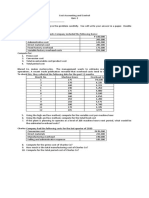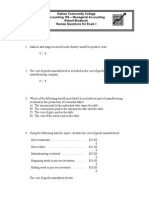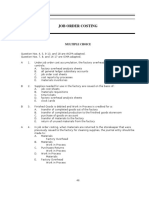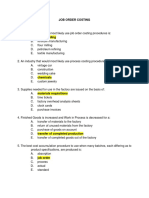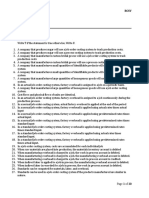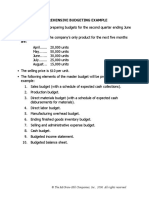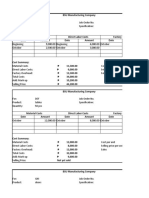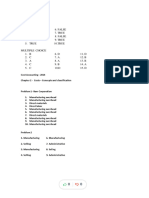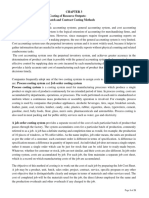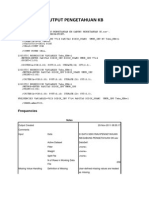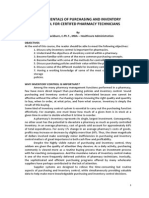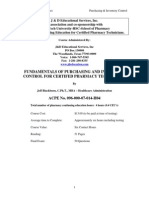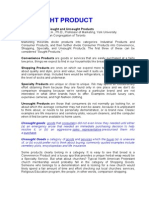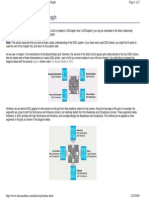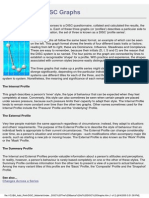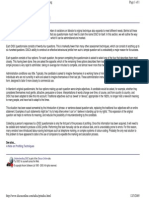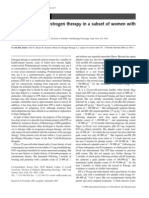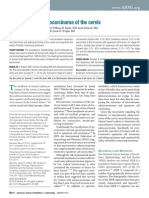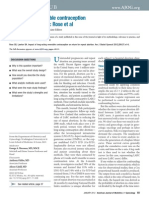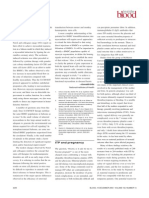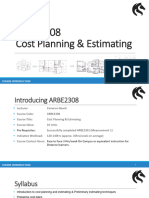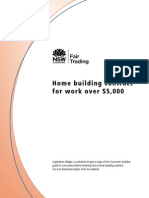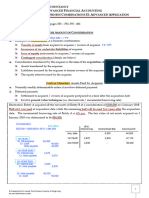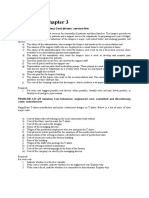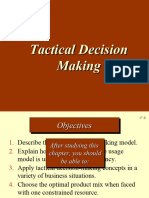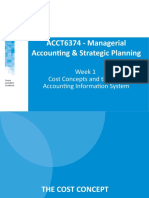0 ratings0% found this document useful (0 votes)
557 viewsJob Order Costing
Job Order Costing
Uploaded by
Nefvi Desqi AndrianiThe document discusses the key aspects of a job order costing system. It begins by listing the learning objectives, which include understanding the documents used in job order costing like bills of materials, material requisition forms, job cost sheets, and labor time tickets. It then provides examples of these documents, explaining how direct materials and direct labor costs are measured and recorded on job cost sheets using material requisition forms and labor time tickets. The document concludes by stating job order costing requires more effort than process costing due to tracking costs for each unique job.
Copyright:
© All Rights Reserved
Available Formats
Download as DOCX, PDF, TXT or read online from Scribd
Job Order Costing
Job Order Costing
Uploaded by
Nefvi Desqi Andriani0 ratings0% found this document useful (0 votes)
557 views43 pagesThe document discusses the key aspects of a job order costing system. It begins by listing the learning objectives, which include understanding the documents used in job order costing like bills of materials, material requisition forms, job cost sheets, and labor time tickets. It then provides examples of these documents, explaining how direct materials and direct labor costs are measured and recorded on job cost sheets using material requisition forms and labor time tickets. The document concludes by stating job order costing requires more effort than process costing due to tracking costs for each unique job.
Original Description:
job order
Original Title
JobOrderCosting
Copyright
© © All Rights Reserved
Available Formats
DOCX, PDF, TXT or read online from Scribd
Share this document
Did you find this document useful?
Is this content inappropriate?
The document discusses the key aspects of a job order costing system. It begins by listing the learning objectives, which include understanding the documents used in job order costing like bills of materials, material requisition forms, job cost sheets, and labor time tickets. It then provides examples of these documents, explaining how direct materials and direct labor costs are measured and recorded on job cost sheets using material requisition forms and labor time tickets. The document concludes by stating job order costing requires more effort than process costing due to tracking costs for each unique job.
Copyright:
© All Rights Reserved
Available Formats
Download as DOCX, PDF, TXT or read online from Scribd
Download as docx, pdf, or txt
0 ratings0% found this document useful (0 votes)
557 views43 pagesJob Order Costing
Job Order Costing
Uploaded by
Nefvi Desqi AndrianiThe document discusses the key aspects of a job order costing system. It begins by listing the learning objectives, which include understanding the documents used in job order costing like bills of materials, material requisition forms, job cost sheets, and labor time tickets. It then provides examples of these documents, explaining how direct materials and direct labor costs are measured and recorded on job cost sheets using material requisition forms and labor time tickets. The document concludes by stating job order costing requires more effort than process costing due to tracking costs for each unique job.
Copyright:
© All Rights Reserved
Available Formats
Download as DOCX, PDF, TXT or read online from Scribd
Download as docx, pdf, or txt
You are on page 1of 43
Job Order Costing System:
After studying this chapter you should be able to:
Distinguish between process costing and job order costing and identify companies that
would use each costing method.
Identify the documents used in job order costing system.
Compute predetermined overhead rates and explain why estimated overhead costs
(rather than actual overhead costs) are used in the costing process.
Understand the flow of costs in a job order costing system and prepare appropriate
journal entries to record costs.
Apply overhead cost to work in process (WIP) using a predetermined overhead rate.
Prepare a schedule of cost of goods manufactured and cost of goods sold.
Prepare T-accounts to show the flow of costs in a job order costing system.
Explain the implications of basing the predetermined overhead rate on activity at
capacity rather than on estimated activity for the period.
job order costing system is used in situations where many different products are produced
each period. For example clothing factory would typically made many different types of jeans
for both men and women during a month. In a job order costing system, costs are traced to
the jobs and then the costs of the job are divided by the number of units in the job to arrive at
an average cost per unit.
Job order costing system is also extensively used in service industries. Hospitals, law firms,
movie studios, accounting firms, advertising agencies and repair shops all use a variety of job
order costing system to accumulate costs for accounting and billing purposes. The details here
deal with a manufacturing firm, the same concept and procedures are used by many service
organizations.
The record keeping and cost assignment problems are more complex in a job order costing
system when a company sells many different products and services than when it has only a
single product or service. Since the products are different, the costs are typically different.
Consequently, cost records must be maintained for each distinct product or job. For example
an attorney in a large criminal law practice would ordinarily keep separate records of the costs
of advising and defending each of her clients. And a clothing factory would keep separate track
of the costs of filling orders for particular styles, sizes, and colors of jeans. A job order costing
system requires more effort than a process costing system. Companies classify manufacturing
costs into three broad categories:
(1) direct materials,
(2) direct labor,
(3) manufacturing overhead. (See manufacturing and non-manufacturing costs page)
As we study the operation of a job costing system, we will see how each of these three types
of costs is recorded and accumulated.
1. Measuring Direct Materials Cost in Job Order Costing System:
At the beginning of production process a document known as bill of materials is used
for standard products. "A bill of materials is a document that lists the type and quantity
of each item of materials needed to complete a unit of standard product". Click here to
read full article.
Learning objective of this article:
1. What is a materials requisition form. Give an example of materials requisition form.
2. What is a job cost sheet. Give an example of job cost sheet.
3. How direct materials cost is measured and recorded on a job cost sheet.
Bill of Materials:
At the beginning of production process a document known as bill of materials is used for
standard products. "A bill of materials is a document that lists the type and quantity of each
item of materials needed to complete a unit of standard product". In case where it is not
possible to use a bill of materials, the production staff determines the materials requirements
from the blueprints submitted by the customer.
Materials Requisition Form:
When an agreement is reached with the customer concerning the quantities, price and
shipment date for the order, a production order is issued. The production department then
prepares a materials requisition form. "The materials requisition form is a detailed source
document that specifies the type and quantity of materials to be drawn from the storeroom,
and identifies the job to which the costs of the materials are to be charged". The form is used
to control the flow of materials into production and also for making entries in the accounting
records. The completed form is presented to the storeroom clerk who then issues the
necessary raw materials. The storeroom clerk is not allowed to release materials without such
a form bearing an authorized signature. Following is an example of a materials requisition
form.
Sample of materials requisition form:
Materials Requisition Number14873
Job Number to Be Charged 2B47
Department Milling
Date March 2
Description Quantity Unit Cost Total Cost
M46 Housing 2 $124 $248
G7 Connector 4 103 412
-------
$660
Authorized Signature Bill White
Job Cost Sheet:
After being notified that the production order has been issued, the Accounting Department
prepares a job cost sheet. A job cost sheet is a form prepared for each separate job that
records the materials, labor and overhead costs charged to the job. After direct materials are
issued , the Accounting department records their costs directly on the job cost sheet.
In addition to serving as a means for charging costs to jobs, the job cost sheet also serves as
a key part of a firm's accounting records. The job cost sheets form a subsidiary ledger to the
work in process (WIP) account. They are detailed records for the jobs in process that add up to
the balance in the work in process (WIP). Following is an example of a job cost sheet.
Example of Job Cost Sheet:
JOB COST SHEET
Job Number 2B47
Department Milling
Item
For Stock
Date Initiated March 2
Date Completed
Units Completed
Direct Materials Direct Labor Manufacturing Overhead
Req. No. Amount Ticket Hours Amount Hours Rate Amount
14873 $660
Cost Summary Units Shipped
Direct Materials $ Date Number Balance
Direct Labor $
Manufacturing Overhead $
Total Cost $
Unit Product Cost $
Read more at
http://www.accounting4management.com/measuring_dircet_materials_cost_job_order_costing.htm#H6c
qvM4m8OGFMKgp.99
2. Measuring Direct Labor Cost in Job Order Costing System:
Direct labor cost is handled in much the same way as direct materials cost. Direct
labor consists of labor charges that are easily traced to a particular job. Labor charges
that cannot be easily traced directly to any job are treated as part of manufacturing
overhead. Click here to read full article.
Learning objective of this article:
1. What is a labor time ticket? Give an example of labor time ticket.
2. How direct labor cost is measured and recorded on job cost sheet in a job order costing
system.
Labor Time Ticket:
Direct labor cost is handled in much the same way as direct materials cost. Direct labor
consists of labor charges that are easily traced to a particular job. Labor charges that cannot
be easily traced directly to any job are treated as part of manufacturing overhead. The later
category of labor cost is known as indirect labor and includes tasks such as maintenance,
supervision, and cleanup. Workers use time tickets to record the time they spend on each job
and task. A completed labor time ticket is an hour by hour summary of the employees
activities throughout on a specific job, the employee enters the job number on the time ticket
and notes the amount of time spent on that job. When not assigned to a particular job, the
employee records the nature of the indirect labor task (such as cleanup and maintenance) and
the amount of time spent on the task. The daily time tickets are also used as the basis for
labor cost entries into the accounting records. Following is an example of employees time
ticket.
Sample of Employee Time Ticket:
Time Ticket No. 843
Employee Mary Holden
Date March 3
Station 4
Started Ended Time Completed Rate Amount Job Number
7:00 12:00 5.0 $9 $45 2B47
12:30 2:30 2.0 9 18 2B50
2:30 3:30 1.0 9 9 Maintenance
Job Cost Sheet:
At the end of the day, the time tickets are gathered and accounting department enters the
direct labor hours and costs on individual job cost sheets. Following is an example of a job cost
sheet.
Example of Job Cost Sheet:
JOB COST SHEET
Job Number 2B47
Department Milling
Item
For Stock
Date Initiated March 2
Date Completed
Units Completed
Direct Materials Direct Labor Manufacturing Overhead
Req. No. Amount Ticket Hours Amount Hours Rate Amount
14873 $660 843 5 $45
Cost Summary Units Shipped
Direct Materials $ Date Number Balance
Direct Labor $
Manufacturing Overhead $
Total Cost $
Unit Product Cost $
The system we have just described is a manual method for recording and posting labor costs.
Many companies now rely on computerized system and no longer record labor time by hand on
sheet of paper. One computerized approach uses bar codes to enter the basic data into the
computer. Each employee and each job has a unique bar code. When an employee begins
work on a job, he or she scans three bar codes using a hand-held device much like the bar
code readers at grocery store check-out stands. The first bar code indicates that a job is being
started; the second is the unique bar code on his or her identity badge; and the third is the
unique bar code of the job itself. This information is fed automatically via an electronic network
to a computer that notes the time and then records all of the data. When the employee
completes the task, he or she scans a bar code attached to the job. This information is relayed
to the computer that again notes the time, and a time ticket is automatically prepared. Since
all of the source data is already in computer files, the labor costs can be automatically posted
to job cost sheets (or their electronic equivalents). Computers, coupled with technology such
as bar codes, can eliminate much of the drudgery involved in routine bookkeeping activities
while at the same time increasing timeliness and accuracy.
In Business:
Relation of Direct Labor to Product Cost:
How much direct labor is in the product you buy? Sometime not very much. During a visit to the Massachusetts Institute of
Technology, Chinese Prime Zhu Rongji claimed that, of the $120 retail cost of a pair of athletic shoes made in china, only $2
goes to the Chinese workers who assemble a $90 pair on Nike sneakers is only $1.20
Source: Robert A. Senser, letter to the editor, Business Week, May 24, 1999, pp. 11-12.
A More Productive Use of Time:
Is it always worth the trouble to fill out labor time ticket ? in a word, no. United Electric Control, Inc., located in Waterton,
Massachusetts, makes temperature and pressure sensors and controls. The manufacturing vice president decided he wanted
employees to spend their time focusing on making products rather than on filling out labor time tickets. The company
converted everyone into salaried workers and stopped producing labor reports.
Source: Richard L. Jenson, James W. Brackner, and Clifford Skousen, Management Accounting in Support of Manufacturing
Excellence, 1996, The IMA Foundation for Applied Research, Inc., Montvale New Jersey, p. 12
High Tech in the Fields:
Advanced technology for recording data is even found in strawberry fields where the pay of workers is traditionally based on
the amount of berries they pick. The Bob Jones Ranch in Oxnard, California, is using dime-sized metal buttons to record how
boxes of fruit each worker picks. The buttons, which are stuffed with microelectronics, are carried by the field workers. The
buttons can be read in the field with a wand like probe that immediately downloads data to a laptop computer. The
information picked up by the probe includes the name of the worker; the type and quality of the crop; and the time, date, and
location of the field being picked. Not only does the system supply the data needed to pay over 700 field workers but it also
provides farm managers with information about which fields are most productive. Previously, two people were required every
night to process the time tickets for the field workers.
Source: Marke Boslet, "Metal Buttons Carried by Crop Pickers Serve as Mini Databases for Farmers," The Wall Street Journal,
May 31, 1994, p. A11a
Read more at
http://www.accounting4management.com/measuring_direct_labor_job_order_costing.htm#4z7MBx0b8KS
gBKK0.99
3. Application of Manufacturing Overhead:
Manufacturing overhead must be included with direct labor on the job cost sheet since
manufacturing overhead is also a product cost. However, assigning manufacturing
overhead to units of product can be a difficult task. Click here to read full article.
Learning objective of this article:
1. Define and explain predetermined manufacturing overhead rate, how is it calculated?
2. How manufacturing overhead is recorded on a job cost sheet and is applied to work in
process? Explain the procedure with an example.
Predetermined Overhead Rate:
Manufacturing overhead must be included with direct labor on the job cost sheet since
manufacturing overhead is also a product cost. However, assigning manufacturing overhead to
units of product can be a difficult task. There are three reasons for this:
1. Manufacturing overhead is an indirect cost. This means that it is either impossible or
difficult to trace these costs to a particular product or job.
2. Manufacturing overhead consists of many different items ranging from the grease used
in machines to the annual salary of production manager.
3. Even though output may fluctuate due to seasonal or other factors, manufacturing
overhead costs tend to remain relatively constant due to the presence of fixed costs.
Given these problems, about the only way to assign overhead costs to production is to use an
allocation process. This allocation of overhead cost is accomplished by selecting an allocation
base that is common to all of the company's products and services. An allocation base is a
measure such as direct labor hours or machine hours that is used to assign overhead costs to
products and services. The most widely used allocation bases are direct labor hours, and direct
labor cost, with machine hours and even units of product (where a company has only a single
product) also used to some extent. The allocation base is used to compute "predetermined
overhead rate" in the following formula or equation.
Formula and Calculation of Predetermined Overhead Rate:
Predetermined Overhead Rate = Estimated total manufacturing overhead cost / Estimated
total units in the allocation base
Example:
If a company has estimated that its total manufacturing overhead cost will be $320,000 for the
year and its total direct labor hour will be 40,000. Its predetermined overhead rate for the
year will be $8 per direct labor hour, as calculated below:
$320,000 / 40,000
= $8 per direct labor hour
predetermined overhead rate is based on estimates rather than actual results. This is because
the predetermined overhead rate is computed before the period begins and is used to apply
overhead cost throughout the period. The process of assigning overhead cost to jobs is called
overhead application. The formula for determining the amount of overhead cost to apply to a
particular job is:
Overhead applied to a particular job = Predetermined overhead rate Amount of allocation
incurred by the job
Note that the job cost sheet in the example below indicates that 27 labor hours have been
worked. Therefore a total of $216 of manufacturing overhead cost would be applied to the job.
See the following calculation:
Overhead applied to job 2B47 = Predetermined overhead rate Actual direct labor hours
charged to job 2B47
= $8 per DLH 27 DLHs
= $216 of overhead applied to job 2B47
Example of Job Cost Sheet
JOB COST SHEET
Job Number 2B47
Department Milling
Date Initiated March 2
Date Completed March 8
Direct Materials Direct Labor Manufacturing Overhead
Req. No. Amount Ticket Hours Amount Hours Rate Amount
14873 $660 843 5 $45 27 $8/DLH $216
14875 506 846 8 60
14912 238 850 4 21
--------- 851 10 54
$1,404 -------- --------
===== 27 $180
===== =====
Cost Summary Units Shipped
Direct Materials $1,404 Date Number Balance
Direct Labor 180 March 8 -- 2
Manufacturing Overhead 216
Total Cost 1800
Unit Product Cost 900
The amount of overhead has been entered on the job cost sheet above. Note that this is not
the actual amount of overhead caused by the job. There is no attempt to trace actual overhead
costs to jobs--if that could be done, the costs would be direct costs, not overhead costs.
Overhead assigned to the job is simply a share of the total overhead that was estimated at the
beginning of the year. When a company applies overhead cost to jobs as we have done--it is
called normal cost system. The overhead may be applied as direct labor-hours are charged to
jobs, or all of the overhead can be applied at once when the job is completed. The choice is up
to the company. If a job is not completed at the year-end, however, overhead should be
applied to value the work in process inventory.
The Need for Predetermined Overhead Rate:
Instead of using a predetermined overhead rate, a company could wait until the end of the
accounting period to compute an actual over head rate based on actual total manufacturing
costs and the actual total units in the allocation base for the period. However, managers cite
several reasons for using predetermined over head rates instead of actual overhead rates:
1. Managers would like to know the accounting system's valuation of completed jobs
before the end of the accounting period. Suppose, for example a company waits until
the end of the year to compute its overhead rate. Then there would be no way for
managers to know the cost of goods sold for a job until the close of the year. The job
may be completed and shipped before the end of the year. The seriousness of this
problem can be reduced to some extent by computing the actual overhead more
frequently, but that immediately leads to another problem as discussed below.
2. If actual overhead rates are computed frequently, seasonal factors in overhead costs or
in the allocation base can produce fluctuations in the overhead rates. For example, the
cost of heating and cooling a production facility will be highest in the winter and
summer months and lowest in the spring and fall. If an overhead rate were computed
each month or each quarter, the predetermined overhead rate would go up in the
winter and summer and down in the spring and fall. Tow identical jobs, one completed
in winter and one completed in spring, would be assigned different costs if the overhead
rate were computed on a monthly or quarterly basis. Managers generally feel that such
fluctuations in overhead rates and costs serve no useful purpose and are misleading.
3. The use of predetermined overhead rate simplifies the record keeping. To determine
the overhead cost to apply t a job, the accounting staff simply multiplies the direct
labor hours recorded for the job by the predetermined overhead rate.
The Flow of Documents in a Job Order Costing System
A sales
order is
prepared
as a basis
for issuing
a.....
A
production
order
initiates
work on a
job,
whereby
costs are
charged
through...
Materials
requisition
form
These production
costs are
accumulated on
a form, prepared
by the
accounting
department
known as...
The job cost sheet is
used to compute unit
product costs that in
turn are used to value
ending inventories and
to determine cost of
goods sold
Sales
Order
Production
Order
Direct labor
time ticket
Job
cost
sheet
Predetermined
overhead
rates
Read more at
http://www.accounting4management.com/job_order_costing_system.htm#DvhLrrEx7uItZaci.99
4. Job Order Costing System - The Flow of Costs:
To understand the flow of costs in job order costing system, we shall consider a
single month's activity for a company, a producer of product A and product B. Click
here to read full article.
Learning objective of this article:
1. Understand the flow of costs in a job order costing system and prepare appropriate
journal entries to record cost.
2. Apply overhead cost to work in process using a predetermined overhead rate.
3. Prepare T accounts to show the flow of costs in a job order costing system.
4. Prepare schedule of cost of goods manufactured and cost of goods sold.
To understand the flow of costs in job order costing system, we shall consider a single
month's activity for a company, a producer of product A and product B. The company has two
jobs in process during April, the first month of its fiscal year. Job 1, of 1000 units of product A
was started in march. By the end of march, $30,000 in manufacturing costs had been recorded
for the job 1. Job 2 an order for 10,000 units of product B was started in April.
The Purchase and Issue of Materials:
On April 1, the company had $7,000 in raw materials on hand. During the month, the company
purchased an additional $60,000 in raw materials. The purchase is recorded in journal entry
(1) below:
(1)
Raw Materials 60,000 Dr.
Accounts Payable 60,000 Cr.
Raw materials is an asset account. Thus, when raw materials are purchased, they are initially
recorded as an asset--not as an expense.
Issue of Direct and Indirect Materials:
During April, $52,000 in raw materials were requisitioned from the storeroom for use in
production. These raw materials include both direct and indirect materials. Entry (2) records
issuing the materials to the production department.
(2)
Work in Process 50,000 Dr.
Manufacturing Overhead 2,000 Dr.
Raw Materials 52,000 Cr.
The materials charged to work in process (WIP) represents direct materials for specific jobs. As
these materials are entered into the work in process account, they are also recorded on the
appropriate job cost sheets. This point is illustrated in Exhibit 1.1 where $28,000 of the
$50,000 in direct materials is charged to Job 1 cost sheet and the remaining $22,000 is
charged to job 2 cost sheet. (In this example, all data are presented in summary form and the
job cost sheet is abbreviated.)
The $2,000 charged to manufacturing overhead in entry (2) represents indirect materials used
in production during April. Observe that the manufacturing overhead account is separate from
work in process account. The purpose of the manufacturing overhead account is to accumulate
all manufacturing overhead costs they are as they are incurred during a period.
Before leaving Exhibit 1.1 we need to point out one additional thing. Notice from the exhibit
that the job cost sheet for job 1 contains a beginning balance of $30,000. We stated earlier
that this balance represents the cost of work done during march that has been carried forward
to April. Also note that work in process account contains the same $30,000 balance. The
reason the $30,000 appears in both places is that the work in process account is a control
account and the job cost sheets form a subsidiary ledger. Thus, the work in process account
contains a summarized total of all costs appearing on the individual job cost sheet for all jobs
in process at any given point in time. (Since the company had only job 1 in process at the
beginning of April, job 1's $30,000 balance on that date is equal to the balance in the work in
process account.
Exhibit 1.1
Issue of Direct Materials Only:
Some times the materials drawn from the raw materials inventory account are all direct
materials. I this case, the entry to record the issue of the materials into production would be
as follows:
Work in process XXX Dr.
Raw materials XXX Cr.
Labor Cost:
As work is performed each day in various departments of the company, employee time tickets
are filled out by workers, collected, and forward to the accounting department. In the
accounting department, wages are computed and the resulting costs are classified as either
direct or indirect labor. This costing and classification for April resulted in the following
summary entry:
(3)
Work in process 60,000 Dr.
Manufacturing overhead 15,000 Dr.
Salaries and wages payable 75,000 Cr.
Only direct labor is added to the work in process account. In this example, direct labor is
$60,000 for April.
At the same time the direct labor costs are added to work in process, they are also added to
the individual job cost sheets, as shown in the Exhibit 1.2. During April, $40,000 of direct labor
cost was charged to job 1 and the remaining $20,000 was charged to job 2. The labor cost
charged to manufacturing overhead represent the indirect costs of the period, such as
supervision, janitorial work, and maintenance.
Exhibit 1.2
Manufacturing Overhead Costs:
All costs of operating the factory other than direct materials and direct labor are classified as
manufacturing overhead costs. These costs are entered directly into the manufacturing
overhead account as they are incurred. To illustrate, assume that the company incurred the
following general factory costs during April:
Utilities (heat, water, and power) $21,000
Rent on factory equipment 16,000
Miscellaneous factory costs 3,000
--------
Total $40,000
======
The following entry records the incurrence of these costs:
(4)
Manufacturing overhead 40,000 Dr.
Accounts Payable 40,000 Cr.
In addition, let us assume that during April, the company recognized $13,000 in accrued
property taxes and that $7,000 in prepaid insurance expired on factory buildings and
equipment. The following entry records these items:
(5)
Manufacturing overhead 20,000 Dr.
Property taxes payable 13,000 Cr.
Prepaid insurance 7,000 Cr.
Finally let us assume that the company recognize $18,000 in depreciation on factory
equipment during April. The following entry records the accrual of this depreciation:
(6)
Manufacturing overhead 18,000 Dr.
Accumulated Depreciation 18,000 Cr.
In short, all manufacturing overhead costs are recorded directly into the manufacturing
overhead account as they are incurred day by day through a period. It is important to
understand that manufacturing overhead is a control account for many--perhaps thousands--of
subsidiary accounts such as indirect materials, indirect labor, factory utilities, and so forth. As
the manufacturing overhead account is debited for costs during a period the various subsidiary
accounts are also debited. In this example we omit the entries to the subsidiary accounts for
the sake of brevity.
Calculation of Predetermined Overhead Rate and Application of Manufacturing Overhead to
Work in Process (WIP):
Since actual manufacturing costs are charged to the manufacturing overhead control account
rather than work in process account. How are manufacturing costs assigned to work in
process? The answer is, by means of the predetermined overhead rate. A predetermined
overhead rate is established at the beginning of each year. The predetermined overhead
rate is calculated by dividing the estimated total manufacturing overhead cost for the
year by the estimated total units in the allocation base (measured in machine hours,
direct labor hours, or some other base). This rate is then used to apply overhead costs to
jobs.
To illustrate assume that the company has used machine hours to compute predetermined
overhead rate and that this rate is $6 per machine hour. Also assume that during April, 10,000
machine hours were worked on Job 1 and 5,000 machine hours were worked on Job 2 (a total
of 15,000 machine hours). Thus, $90,000 in overhead cost (15,000 machine hours $6 per
machine hour = $90,000) would be applied to work in process. The following entry records the
application of manufacturing overhead to work in process:
(7)
Work in process 90,000 Dr.
Manufacturing overhead 90,000 Cr.
The flow of cost through the manufacturing overhead account in Exhibit 1.3
Exhibit 1.3
The actual overhead cost in the manufacturing overhead account in Exhibit 1.3 are the costs
that were added to the account in entries (2)--(6). Observe that the incurrence of these actual
overhead costs and the application of overhead to work in process represents two separate
and entirely distinct processes.
The Concept of Clearing Account:
The manufacturing overhead account operates as a clearing account. As we have noted, actual
factory overhead costs are debited to the accounts as they are incurred day by day through
the year. A certain intervals during the year, usually when a job is completed, overhead cost is
applied to the job by means of the predetermined overhead rate, and work in process is
debited and manufacturing overhead is credited. This sequence of events is illustrated below:
Manufacturing Overhead
(a clearing account)
Actual overhead costs are charged to this
account as they are incurred throughout the
period.
Overhead is applied to work in process using
the predetermined overhead rate.
As we emphasized earlier, the predetermined overhead rate is based on estimates of what
overhead costs are expected to be, and it is established before the year begins. As a result,
the overhead cost applied during a year will almost certainly turn out to be more or less than
the overhead cost that is actually incurred. For example, notice from Exhibit 1.3 that the
company's actual overhead costs for the period are $5,000 greater than the overhead cost that
has been applied to work in process (WIP), resulting in a $5,000 debit balance in the
manufacturing overhead account. This debit balance in manufacturing overhead account is
called under-applied overhead. Any credit balance in manufacturing overhead account is called
over-applied overhead. Any balance in the manufacturing overhead account (under or over-
applied overhead) is treated in one of the following ways:
1. Closed out to cost of goods sold
2. Allocated between work in process, finished goods, and cost of goods sold in proportion
to the overhead applied during the current period in the ending balance of these
accounts.
These two methods are illustrated on Disposition of Under- or Over-applied Overhead Balances
page.
For the moment, we can conclude by nothing from Exhibit 1.3 that the cost of a completed job
consists of the actual materials cost of the job, the actual labor cost of the job, and the
overhead cost applied to the job. Pay particular attention to the following subtle but important
point: Actual overhead costs are not charged to jobs; actual overhead costs do not appear on
the job cost sheet nor do they appear in the work in process account. Only the applied
overhead cost, based on the predetermined overhead rate, appear on the job cost sheet and in
the work in process account. Study this point carefully.
Non-manufacturing Costs:
In addition to manufacturing costs, companies also incur marketing and selling costs. These
costs should be treated as period expenses and charged directly to the income statement and
therefore should not go into the the manufacturing overhead account. To illustrate the correct
treatment of non-manufacturing costs, assume that the company (in this example) incurred
$30,000 in selling and administrative salary costs during a months, the following entry records
these salaries.
(8)
Salaries expense 30,000 Dr
Salaries and wages payable 30,000 Cr
Depreciation on factory equipment is debited to manufacturing overhead account but
depreciation on office equipment is considered a period expense and is not included in
manufacturing overhead. Assume that depreciation of office equipment during the month was
$7,000. The entry is as follows.
(9)
Depreciation expense 7,000 Dr
Accumulated depreciation 7,000 Cr
Finally assume that advertising was $42,000 and that other selling and administrative
expenses during the month was $8,000. The following journal entry records these items:
(10)
Advertising expenses 42,000 Dr.
Other selling and administrative expense 8,000 Dr.
Accounts payable 50,000 Cr.
Since the amounts in entries above all go directly into expense accounts, they will have no
effect on the costing of the company's production for the month. The same will be true of any
other selling and administrative expenses incurred during the month including sales
commission, depreciation on sales equipment, rent on office facilities, insurance on office
facilities, and related costs.
Cost of Goods Manufactured (COGM):
When a job has been completed, the finished out put is transferred from the production
department to the finished goods warehouse. By this time, the accounting department will
have charged the job with direct materials and direct labor cost and manufacturing overhead
will have been applied using the predetermined overhead rate. A transfer of costs is made
within the costing system that parallels the physical transfer of the goods to the finished goods
warehouse. The costs of the completed jobs are transferred out of the work in process (WIP)
account and into the finished goods account. The sum of all amounts transferred between
these two accounts represents the cost of goods manufactured for the period.
Let us assume that the job 1 was completed during the period. The following entry transfers
the cost of job 1 from work in process (WIP) to finished goods.
(11)
Finished goods 158,000 Dr.
Work in process 158,000 Cr
The $158,000 represents the completed cost of job 1, as shown on the job cost sheet in
Exhibit 1.3. Since job 1 was the only job completed during April, the $158,000 also represents
the cost of goods manufactured for the month.
The job 2 was not completed by month-end, so its cost will remain in the work in process
(WIP) account and carry over to the next month. If a balance sheet is prepared at the end of
April, the cost accumulated thus far on the job 2 will appear as "work in process inventory" in
the assets section.
Cost of Goods Sold (COGS):
As units in the finished goods are shipped to the customers, their costs are transferred from
the finished goods account into the cost of goods sold account. If complete job is shipped, as
in the case where a job has been done to a customer's specification then it is a simple matter
to transfer the entire cost appearing on the job cost sheet into the cost of goods sold account.
In most cases, only a portion of the units involved in a particular job will be immediately sold.
In these situations the unit cost must be used to determine how much product cost should be
removed from finished goods and charged to cost of goods sold.
Assume that the company has completed 1000 units and 750 out of 1000 units have been
shipped to customers for a price of $225,000. The unit product cost is $158. Following journal
entries would record the sales (all sales are on account).
(12)
Accounts receivable 225,000 Dr.
Sales 225,000 Cr.
(13)
Cost of goods sold 118,5000* Dr.
Finished goods 118,5000 Cr.
($158 750units = $118,500*)
With entry (13), the flow of cost through our job order costing system is completed.
Summary of Cost Flow:
To pull the entire example together, journal entries (1) through (13), T accounts, and
schedules of cost of goods manufactured and cost of goods sold are presented below:
Journal Entries:
(1)
Raw Materials 60,000 Dr.
Accounts Payable
60,000 Cr.
(2)
Work in process 50,000
Dr.
Manufacturing overhead 2,000 Dr.
Raw materials 52,000 Cr.
(3)
Work in process 60,000
Dr.
Manufacturing overhead 15,000 Dr.
Salaries and wages 75,000 Cr.
(4)
Manufacturing overhead 40,000 Dr.
Accounts payable 40,000 Cr.
(5)
Manufacturing overhead 20,000 Dr.
Property taxes payable 13,000 Cr.
Prepaid insurance 7,000 Cr.
(6)
Work in process 18,000
Manufacturing overhead 18,000
(7)
Work in process 90,000 Dr.
Manufacturing overhead 90,000 Cr.
(8)
Salaries expenses 30,000 Dr.
Salaries and wages payable 30,000 Cr.
(9)
Depreciation expense 7,000 Dr.
Accumulated depreciation 7,000 Cr.
(10)
Advertising expense 42,000 Dr
Other selling and administrative expense 8,000 Dr.
Accounts payable 50,000 Cr.
(11)
Finished goods 158,000 Dr.
Work in process 158,000 Cr.
(12)
Accounts receivable 225,000
Sales 225,000
(13)
Cost of goods sold 118,500
Finished goods
118,500
T Accounts:
Accounts Receivable
Accounts Payable
Capital Stock
xx
(12) 225,000
xx
(1) 60,000
(4) 40,000
xx
(10) 50,000
Prepaid Insurance
Salaries and Wages Payable
Retained Earnings
xx
(5) 7,000
xx
(3) 75,000
(8) 30,000
xx
Raw Materials
Property Taxes Payable
Sales
Bal. 7,000
(1) 60,000
(20) 52,000
xx
(5) 13,000
(12) 225,000
Bal. 15,000
Cost of Goods Sold
Work in Process
Salaries expenses
(13) 118500
Bal. 30,000
(2) 50,000
(3) 60,000
(7) 90,000
(11) 158,000
(8) 30,000
Depreciation expenses
(9) 7,000
Bal. 72,000
Finished Goods
Advertising Expenses
Bal. 10,000
(11) 158,000
(13) 118,500
(10) 42,000
Bal. 49,000
Accumulated Depreciation
Other Selling and Administrative
expenses
xx
(6) 18,000
(9) 7,000
(10) 8,000
Manufacturing Overhead
(2) 2000
(3) 15,000
(4) 40,000
(5) 20,000
(6) 18,000
(7) 90,000
Bal. 5,000
Explanation of entries:
(1) Raw materials purchased.
(2) Direct and indirect materials issued into production. (8) Administrative salaries expenses incurred.
(3) Direct and indirect factory labor cost incurred. (9) Depreciation recorded on office equipment.
(4) Utilities and other factory costs incurred. (10) Advertising and other expenses incurred
(5) Property taxes and insurance incurred on the
factory.
(11) COGM transferred into finished goods.
(6) Depreciation recorded on the factory assets. (12) sale of job 1 recorded.
(7) Overhead cost applied to work in process. (13) Cost of goods sold recorded for job 1.
XX = Normal balance in the account (for example accounts receivable normally carries a debit balance).
Cost of Goods Manufactured:
Direct materials $50,000
Direct labor $60,000
Manufacturing overhead applied to work in process
$90,000*
---------------
Total Manufacturing cost $200,000
Add: Beginning work in process $30,000
------------
$230,000
Deduct: Ending work in process inventory $72,000
-----------
Cost of goods manufactured $158,000
=======
Cost of Goods Sold:
Finished goods inventory beginning $10,000
$158,000
-----------
Goods available for sale $168,000
Deduct: Finished goods inventory ending $49,500
----------
Unadjusted cost of goods sold $118,500
Add: Under applied overhead
$5,000*
-----------
Adjusted cost of goods sold $123,500
=======
*Overhead applied = $90,000 (15,000 Direct labor hours $6.00 Predetermined overhead rate)
Actual overhead = $95,000
Under applied overhead = $95,000 (actual) - $90,000 (applied) = $5,000
Entry to close the $5,000 of under applied to cost of goods sold would be as follows:
Cost of goods sold--------------------------------- 5,000 Dr
Manufacturing overhead-------------------------------- 5,000 Cr
Note that the under-applied overhead is added to cost of goods sold. If overhead were over-applied, it
would be deducted from cost of goods sold.
Income Statement:
Sales $225,000
Les cost of goods sold ($ 118,500 + $5,000) 123,500
-----------
Gross margin
101,500
Less selling and administrative expenses:
Salaries $30,000
Depreciation 7,000
Advertising expenses 42,000
Other expense 8,000 87,000
---------- -----------
Net operating income $14,500
=======
Read more at
http://www.accounting4management.com/job_order_costing_flow_of_cost.htm#RMotbs6AS1gvtEIO.99
5. Multiple Predetermined Overhead Rates:
When a single predetermined overhead rate is used for entire factory it is called plant
wide overhead rate. This is fairly common practice - particularly in smaller companies.
Click here to read full article.
Multiple Predetermined Overhead Rates:
Learning Objectives of the Article:
1. What are multiple predetermined overhead rates?
2. What is the need of calculating multiple predetermined overhead rates?
When a single predetermined overhead rate is used for entire factory it is called plant wide
overhead rate. This is fairly common practice - particularly in smaller companies. But in large
companies, multiple predetermined overhead rates are often used.
In a multiple predetermined overhead rate system, each production department may have
its own predetermined overhead rate. Such a system, while more complex, is considered to be
more accurate. Since it can reflect differences across departments in how overhead costs are
incurred. For example, overhead might be allocated based on machine-hours in departments
that are relatively machine intensive. When multiple predetermined overhead rates are used,
overhead is applied in each department according to its own overhead rate as a job proceeds
through the department.
In Business:
Enhancing the Accuracy of Product Costs
Only 34% of surveyed manufacturing firms reported that they used a single, plant wide overhead rate. The use of multiple
overhead rates to obtain more accurate product costs was reported by 44% of the firms. The remaining 22% use activity
based costing--an even more complex, and presumably more accurate, approach to the allocation of overhead costs to
products.
Source: Eun-Sup Shim and Joseph M. Larkin, "A survey of current managerial accounting practices: Where do we stand,"
Ohio CPA Journal, February 1994, p. 21 (4pages).
Read more at
http://www.accounting4management.com/multiple_predetermined_overhead_rates.htm#KEdy4O4VmXQI
PB4T.99
6. Under-applied overhead and over-applied overhead calculation:
Since the predetermined overhead rate is established before a period begins and is
based entirely on estimated data, the overhead cost applied to work in process (WIP)
will generally differ from the amount of overhead cost actually incurred during a period.
Click here to read full article.
Learning objectives of this article:
1. Define, explain and calculate under-applied and over-applied overhead rate. Give an
example.
Definition and Explanation of Over and Under-applied Overhead:
Since the predetermined overhead rate is established before a period begins and is based
entirely on estimated data, the overhead cost applied to work in process (WIP) will generally
differ from the amount of overhead cost actually incurred during a period. The difference
between the overhead cost applied to work in process (WIP) and the actual
overhead costs of a period is termed as either underapplied overhead or overapplied
overhead. For example if a company calculates its predetermined overhead rate $6 per
machine hour. 15,000 machine hours are actually worked and overhead applied to production
is therefore $90,000 (15,000 hours $6). If actual factory overhead is $95,000 then
underapplied overhead is $5,000 ($95,000 $90,000). If the situation is reverse and the
company applies $95,000 and actual overhead is $90,000 the overapplied overhead would be
$5,000.
Causes / Reasons of under applied or over applied overhead:
The causes / reasons of under or over-applied overhead can be complex. Nevertheless the
basic problem is that the method of applying overhead to jobs using a predetermined overhead
rate assumes that actual overhead costs will be proportional to the actual amount of the
allocation base incurred during the period. If, for example, the predetermined overhead rate is
$6 per machine hour, then it is assumed that actual overhead cost incurred will be $6 for
every machine hour that is actually worked. There are actually two reasons why this may not
be true. First, much of the overhead often consists of fixed costs that do not grow as the
number of machine hours incurred increases. Second, spending on overhead items may or
may not be under control. If individuals who are responsible for overhead costs do a good job,
those costs should be less than were expected at the beginning of the period. If they do a poor
job, those costs will be more than expected.
Example:
Suppose that two companies A and B have prepared the following estimated data for the
coming year:
Company
A B
Predetermined overhead rate based on Machine-hours
Direct materials
cost
Estimated manufacturing overhead $300,000 $120,000
Estimated machine-hours 75,000 --
Estimated direct materials cost
$80,000
Predetermined overhead rate, (a) (b) $4 per machine hour
150% of direct
materials cost
Now assume that because of unexpected changes in overhead spending and changes in
demand for the companies' products, the actual overhead cost and the actual activity
recorded during the year in each company are as follows:
Company
A B
Actual manufacturing overhead costs $290,000 $130,000
Actual machine-hours 68,000 --
Actual direct materials costs -- $90,000
For each company, note that the actual data for both cost and activity differ from the
estimates used in computing the predetermined overhead rate. This results in underapplied
overhead and overapplied overhead as follows:
Company
A B
Actual manufacturing overhead costs $290,000 $130,000
Manufacturing overhead cost applied to work in process during the year:
68,000 actual machine hours $4 per machine hour 272,000
$90,000 actual direct materials cost 150% of direct materials cost 135,000
------------- -------------
Under-applied (over-applied) overhead $ 18,000 $ (5,000)
For company A, notice that the amount of overhead cost that has been applied to work in
process ($272,000) is less than the actual overhead cost for the year ($290,000). Therefore
the overhead is under-applied. Also notice that original estimate of overhead in company A
($300,000) is not directly involved in this computation. Its impact is felt only through the $4
predetermined overhead rate that is used.
For B company the amount of overhead cost that has been applied to work in process (WIP)
($135,000) is greater than the actual overhead cost for the year ($130,000), and so
overhead is over-applied. A summary of the concepts discussed so for is presented below:
At the beginning of the period
Estimated total manufacturing
overhead cost
Estimated total units in the allocation
base
= Predetermined overhead rate
During the period
Predetermined overhead rate
Actual total units of the allocation base
incurred during the period
=
Total manufacturing overhead
applied
At the end of the period
Actual total manufacturing overhead
cost
Total manufacturing overhead
applied
=
Under-applied (over-applied)
overhead
What disposition should be made of any under or over applied overhead balance
remaining in the manufacturing overhead account at the end of a period? To
understand the procedure of disposing off any under or over applied overhead see disposition
of any balance remaining in the manufacturing overhead account at the end of a period page
Read more at
http://www.accounting4management.com/underapplied_and_overapplied_overhead.htm#QKeYJT5apmg
Gto8r.99
7. Disposition of any balance remaining in the manufacturing overhead account
at the end of a period:
What disposition should be made of an under-applied overhead or over-applied
overhead balance remaining in the manufacturing overhead account at the end of a
period? Click here to read full article.
Learning objective of the article:
1. How is over and under applied overhead is disposed off. Give an example to explain the
procedure?
What disposition should be made of an underapplied overhead or overapplied
overhead balance remaining in the manufacturing overhead account at the end of a
period?
Generally any balance in the account is treated in one of the two ways.
1. Closed out to cost of goods sold.
2. Allocated between work in process (WIP), finished goods and cost of goods sold in
proportion to the overhead applied during the current period in the ending balances of
these account.
The second method, which allocates the under or overapplied overhead among ending
inventories and cost of goods sold is equivalent to using an "actual" overhead rate and is for
that reason considered by many to be more accurate than the first method. Consequently, if
the amount of underapplied or overapplied overhead is material, many accountants would
insist that the second method be used.
Closed Out to Cost of Goods Sold:
Closing out the balance in manufacturing overhead account to cost of goods sold is simpler
than the allocation method.
Where the overhead is underapplied following journal entry is made:
Cost of goods sold
Manufacturing overhead
Dr
Cr
Where the overhead is overapplied the following journal entry is made:
Manufacturing overhead
Cost of goods sold
Dr
Cr
After passing one of these journal entries, cost of goods sold is adjusted. Consequently cost of
goods sold is increased by the amount of underapplied and decreased by the amount of
overapplied overhead.
Example:
Cost of Goods Manufactured:
Direct materials $50,000
Direct labor $60,000
Manufacturing overhead applied to work in process $90,000*
---------
Total Manufacturing cost $200,000
Add: Beginning work in process $30,000
----------
$230,000
Deduct: Ending work in process inventory $72,000
----------
Cost of goods manufactured $158,000
========
Cost of Goods Sold:
Finished goods inventory beginning $10,000
$158,000
-----------
Goods available for sale $168,000
Deduct: Finished goods inventory ending $49,500
----------
Unadjusted cost of goods sold $118,500
Add: Under applied overhead $5,000*
----------
Adjusted cost of goods sold $123,500
========
*Overhead applied = $90,000 (15,000 Direct labor hours $6.00 Predetermined overhead rate)
Actual overhead = $95,000
Under applied overhead = $95,000 - $90,000 = $5,000
Entry to close the $5,000 of under applied to cost of goods sold would be as follows:
Cost of goods sold-------------------------- 5,000 Dr
Manufacturing overhead------------------------- 5,000 Cr
Allocated Between Accounts:
Allocation of under or overapplied overhead between work in process (WIP), finished goods
and cost of goods sold (COGS) is more accurate than closing the entire balance into cost of
goods sold. The reason is that allocation assigns overhead costs to where they would have
gone in the first place had it not been for the errors in the estimates going into the
predetermined overhead rate.
Example:
If the amount of under-applied or over-applied overhead is significant, it should be allocated
among the accounts containing applied overhead: Work in Process Inventory,
Finished Goods Inventory, and Cost of Goods Sold. A significant amount of under-
applied or over-applied overhead means that the balances in these accounts are
quite different from what they would have been if actual overhead costs had been
assigned to production.
Allocation restates the account balances to conform more closely to actual historical
cost as required for external reporting by generally accepted accounting
principles. The above figure uses assumed data for the Cutting and Mounting Department to
illustrate the proration of over-applied overhead among the necessary accounts; had the
amount been under-applied, the accounts debited and credited in the journal entry would be
the reverse of that presented for over-applied overhead. A single overhead account is used in
this illustration.
Theoretically, under-applied or over-applied overhead should be allocated based on
the amounts of applied overhead contained in each account rather than on total
account balances. Use of total account balances could cause distortion because they contain
direct material and direct labor costs that are not related to actual or applied overhead. In
spite of this potential distortion, use of total balances is more common in practice for
two reasons: First, the theoretical method is complex and requires detailed account analysis.
Second, overhead tends to lose its identity after leaving Work in Process Inventory, thus
making more difficult the determination of the amount of overhead in Finished Goods
Inventory and Cost of Goods Sold account balances
Read more at
http://www.accounting4management.com/disposition_of_underapplied_and_overapplied_overhead_bala
nces.htm#HSfimLXseyM0xJlT.99
8. Predetermined Overhead Rate and Capacity:
Companies typically base their predetermined overhead rates on the estimated, or
budgeted, amount of allocation base for the upcoming period. This is the method that is
used in this chapter, but it is practice that is recently come under severe criticism. An
example will be very helpful why. Click here to read full article.
9. Companies typically base their predetermined overhead rates on the estimated, or
budgeted, amount of allocation base for the upcoming period. This is the method that is
used in this chapter, but it is practice that is recently come under severe criticism. An
example will be very helpful why.
10. Example:
11. A corporation manufactures music CDs for local recording studios. The company's CD
duplicating machine is capable of producing a new CD every 10 seconds from a master
CD. The company leases the CD duplicating machine for $180,000 per year, and this is
the company's only manufacturing overhead. With allowances for setups and
maintenance, the machine is theoretically capable of producing up to 900,000 CDs per
year. However due to weak retail sales of CDs the company's commercial customers are
unlikely to order more than 6,00,000 CDs next year. The company uses machine time
as the allocation base for applying manufacturing overhead. These data are
summarized below:
Music Corporation Data
Total manufacturing overhead cost $180,000 per year
Allocation base: machine time per CD 10 seconds per CD
Capacity 900,000 CDs per year
Budgeted output for next year 600,000 CDs
12. If corporation follows common practice and computes its predetermined overhead rate
using estimated or budgeted figures then its predetermined overhead rate for next year
would be $0.03 per second of machine time computed as follows:
13. Predetermined overhead rate = Estimated total manufacturing overhead cost /
Estimated total units in the allocation base
14. $180,000 /( 600,000 CDs 10 seconds per CD)
15. = $0.03 per second
16. Since the CD requires 10 seconds of machine time, each CD will be charged for $0.30 of
overhead cost.
17. Critics charge that there are two problems with this procedure. First, if predetermined
overhead rates are based on budgeted activity, then the unit product cost will fluctuate
depending on the budgeted level of activity for the period. For example, If the budgeted
output for the year was only 3,00,000 CDs, the predetermined overhead rate would be
$0.06 per second of machine time or $0.60 per CD rather than $0.30 per CD. In
general if budgeted output falls, the overhead cost per unit will increase; it will appear
that the CDs cost more to market. Managers may then be tempted to increase prices at
the worst possible time--just as demand is falling.
18. Second critics charge that under traditional approach, products are charged for
resources they don't use. when the fixed costs of capacity are spread over estimated
activity, the units that are produced must shoulder the costs of unused capacity. That is
why the applied overhead cost per unit is increases as the level of activity falls. The
critics argue that products should be charged only for the capacity that they use; they
should not be charged for the capacity they don't use. This can be accomplished by
basing the predetermined overhead rate on capacity as follows:
19. [Predetermined overhead rate based on capacity = Estimated total manufacturing
overhead cost at capacity / Estimated total units in the allocation base at capacity]
20. = $180,000 / (900,000 CDs 10 seconds per CD)
21. = $0.02 per second
22. Since the predetermined overhead rate is $0.02 per second, the overhead cost applied
to each CD would be $0.20. This charge is constant and would not be affected by the
level of activity during a period. If output falls, the charge would still be $0.20 per CD.
23. This method will almost certainly result in under-applied overhead. If actual output at
the music corporation is 600,000 CDs, then only $120,000 of overhead cost would be
applied to products ($0.20 per CD 600,00 CDs). Since the actual overhead cost is
$180,000, then there would be under-applied overhead of $60,000. In another
departure from tradition, the critics suggest that the under-applied overhead that
results from idle capacity should be separately disclosed on the income statement as
the cost of unused capacity--a period expense. Disclosing this cost as a lump sum on
the income statement, rather than burying it in cost of goods sold or ending
inventories, makes it much more visible to managers.
24. Official pronouncements do not prohibit basing predetermined overhead rates on
capacity for external reports. Nevertheless, basing the predetermined overhead rate on
estimated or budgeted, activity is a long-established practice in industry, and some
managers and accountants may object to the large amounts of under-applied overhead
that would often result from using capacity to determine predetermined overhead rates.
And some may insist that the under-applied overhead be allocated among cost of goods
sold and ending inventories--which would defeat the purpose of basing the
predetermined overhead rate on capacity.
25. Read more at
http://www.accounting4management.com/predetermined_overhead_rate_and_capacity.htm#IkI
WS9hy9HW407W5.99
26. Recording Non - manufacturing Costs:
In addition to manufacturing costs, companies also incur marketing and selling costs.
These costs should be treated as period expenses and charged directly to the income
statement and therefore should not go into the the manufacturing overhead account.
Click here to read full article.
27. In addition to manufacturing costs, companies also incur marketing and selling costs.
These costs should be treated as period expenses and charged directly to the income
statement and therefore should not go into the the manufacturing overhead account.
28. Example:
29. To illustrate the correct treatment of non-manufacturing costs, assume that a company
incurred $30,000 in selling and administrative salary costs during a months, the
following entry records these salaries.
Salaries expense 30,000 Dr.
Salaries and wages payable 30,000 Cr.
30. Depreciation on factory equipment is debited to manufacturing overhead account but
depreciation on office equipment is considered a period expense and is not included in
manufacturing overhead. Assume that depreciation of office equipment during the
month was $7,000. The entry is as follows:
Depreciation expense 7,000 Dr.
Accumulated depreciation 7,000 Cr.
31. Finally assume that advertising was $42,000 and that other selling and administrative
expenses during the month was $8,000. The following journal entry records these
items:
Advertising expenses 42,000 Dr.
Other selling and administrative expense 8,000 Dr.
Accounts payable 50,000 Cr.
32. Since the amounts in entries above all go directly into expense accounts, they will have
no effect on the costing of the company's production for the month. The same will be
true of any other selling and administrative expenses incurred during the month
including sales commission, depreciation on sales equipment, rent on office facilities,
insurance on office facilities, and related costs.
33. Read more at
http://www.accounting4management.com/recording_nonmanufacturing_costs_job_order_costing
.htm#1DkZtMReEIswHlrh.99
34. Recording Cost of Goods Manufactured and Sold:
When a job has been completed, the finished out put is transferred from the production
department to the finished goods warehouse. By this time, the accounting department
will have charged the job with direct materials and direct labor cost and manufacturing
overhead will have been applied using the predetermined overhead rate. Click here to
read full article.
Cost of Goods Manufactured (COGM):
When a job has been completed, the finished out put is transferred from the production
department to the finished goods warehouse. By this time, the accounting department will
have charged the job with direct materials and direct labor cost and manufacturing overhead
will have been applied using the predetermined overhead rate.
A transfer of costs is made within the costing system that parallels the physical transfer of the
goods to the finished goods warehouse. The costs of the completed jobs are transferred out of
the work in process (WIP) account and into the finished goods account. The sum of all
amounts transferred between these two accounts represents the cost of goods manufactured
for the period.
Let us assume that a company completed a job during the period. The following journal entry
transfers the cost of the job from work in process (WIP) to finished goods.
Finished goods 158,000 Dr.
Work in process 158,000 Cr.
The $158,000 represents the cost of completed job.
Cost of Goods Sold (COGS):
As units in the finished goods are shipped to the customers, their costs are transferred from
the finished goods account into the cost of goods sold account. If complete job is shipped, as
in the case where a job has been done to a customer's specification then it is a simple matter
to transfer the entire cost appearing on the job cost sheet into the cost of goods sold account.
In most cases, only a portion of the units involved in a particular job will be immediately sold.
In these situations the unit cost must be used to determine how much product cost should be
removed from finished goods and charged to cost of goods sold.
Example:
Assume that a company has completed 1000 units and 750 out of 1000 units have been
shipped to customers for a price of $225,000. The unit product cost is $158. Following journal
entries record this information.
(1)
Accounts receivable 225,000 Dr.
Sales 225,000 Cr.
(2)
Cost of goods sold 118,5000* Dr.
Finished goods 118,5000 Cr.
($158 750units = $118,500*)
With this entry the flow of cost through job order costing system is completed.
Read more at
http://www.accounting4management.com/recoring_cost_of_goods_manufactured_job_order_costing.ht
m#ybQp3g1d9qhdZkVX.99
35. Job Order Costing in Services Companies:
Job order costing is also used in service organizations such as law firms, movie studios,
hospitals, and repair shops, as well as manufacturing companies. Click here to read full
article.
Job order costing is also used in service organizations such as law firms, movie studios,
hospitals, and repair shops, as well as manufacturing companies. In a law firm, for
example, each client represents a "job," and the costs of that job are accumulated day by
day on a job cost sheet as the client's case is handled by the firm. Legal forms and similar
inputs represent the direct materials for the job; the time expended by attorneys
represents the direct labor; and the costs secretaries, clerks, rent, depreciation, and so
forth, represent the overhead.
In a movie studio, each film produced is a "job," and costs for direct materials (customs,
props, film, etc.) and direct labor (actors, directors and extras) are accounted for and
charged to each film's job cost sheet. A share of the studio's overhead costs, such as
utilities, depreciation of equipment, wages of maintenance workers, and so forth, is also
charged to each film. However, the method used by some studios to distribute overhead
costs among movies are controversial and sometimes result in lawsuits.
In sum, the reader should be aware that Job order costing is a versatile and widely used
costing method, and may be encountered in virtually any organization that provides
diverse products or services.
Read more at
http://www.accounting4management.com/job_order_costing_in_service_companies.htm#P7C8
Es5zgVyhKw8P.99
36. Use of Information Technology in Job Order Costing:
Bar code technology can be used to record labor time--reducing the drudgery in that
task and increasing accuracy. Bar codes also have many other uses. In a company with
a well-developed bar code system, the manufacturing cycle begins with the receipt of a
customer's order in electronic form. Click here to read full article.
Learning objectives of the articles:
What are advantages of using bar code technology in job order costing system.
Bar code technology can be used to record labor time--reducing the drudgery in that task
and increasing accuracy. Bar codes also have many other uses. In a company with a well-
developed bar code system, the manufacturing cycle begins with the receipt of a customer's
order in electronic form. Until very recently, the order would have been received via
electronic data interchange (EDI), which involves a network of computers linking
organizations. An EDI network allows companies to electronically exchange business
documents and other information that extend into all areas of business activity from ordering
raw materials to shipping completed goods. EDI was developed in the 1980s and requires
significant investments in programming and networking hardware. Recently, EDI has been
challenged by a far cheaper web-based alternative--XML (Extensible Markup Language),
an extension of HTML (Hypertext Markup Language). HTML uses codes to tell your web
browser how to display information on your screen, but the computer does not what the
information is--it just displays it. XML provides additional tags that identify the kind of
information that is being exchanged. For example, price data might be coded as
<price>14.95<price>. When your computer reads this data and sees the tag <price>
surrounding 14.95, your computer will immediately know that this is a price. XML tags can
designate many different kinds of information--customer orders, medical records, bank
statements, and so on--and the tags will indicate to your computer how to display, store, and
retrieve the information. Office Depot is an early adopter of XML, which it is using to facilitate
e-commerce with its big customers.
Once an order has been received via EDI or over the web in the form of an XML file, the
computer draws up a list of required raw materials and sends out electronic purchase orders to
suppliers. When materials arrive at the company's plant from the suppliers, bar codes that
have been applied by the suppliers are scanned to update inventory records and to trigger
payment for the materials. The bar codes are scanned again when the materials are
requisitioned for use in production. At that point, the computer credits the raw materials
inventory account for the amount and type of goods requisitioned and charges the work in
process inventory account.
A unique bar code is assigned to each job. This bar code is scanned to update work in
process records for labor and other costs incurred in the manufacturing process. When goods
are completed, another scan is performed that transfers both the cost and quantity of goods
from the work in process inventory account to the finished goods inventory account, or
charges cost of goods sold for goods ready to be shipped.
Goods ready to be shipped are packed into containers, which are coded with information that
includes the customer number, the type and quantity of goods being shipped, and the order
number. This bar code is then used for preparing billing information and for tracking the
packed goods until placed on a carrier for shipment to the customer. Some customers require
that the packed goods be bar coded with point-of-sale labels that can be scanned at retail
check-out counters. These scans allow the retailer to update inventory records, verify price,
and generate a customer receipt.
In short bar code technology is being integrated into all areas of business activity. When
combined with EDI or XML, it eliminates a lot of clerical drudgery and allows companies to
capture and exchange more data and to analyze and report information much more quickly
and completely and with less error than with manual system.
Using XML to Enhance Web Commerce:
w.w. Grainger Inc. is in the unglamorous, but important, business of selling maintenance and repair supplies to organizations.
For an effective web-based catalog, the company needs up-to-date, detailed product descriptions from its own suppliers.
Grainger is using software from OnDisplay Inc. to collect product descriptions from vendors' databases and to add XML tags.
When Grainger's customers request product information on the web, this data can be displayed in a standard format. This
process cuts in half the amount of the time required to post new product information to Grainger's web catalog.
If you would like to know more about XML, refer to the World Wide Web Consortium (W3C) website.
Source: John J. Xenakis, CFO, October 1999, pp. 31-36.
Managing Diversity With Technology:
Andersen Windows of Bayport, Minnesota, has developed techniques that allows it to produce just about any window
configuration that a customer might order. Andersen has installed hundreds of Macintosh-based systems for designing
windows at distributors and retailers around the country. Beginning with a standard design from the company's catalog, this
system allows a customer to "add, change, and strip away features until they have designed a window they are pleased
with...The computer automatically checks the window specs for structural soundness, and then generates a price quote." Once
the sale is made, the retailers computer transmits the order with all of the necessary specifications to Andersen. At Andersen,
the order is assigned a unique number and is tracked "in real time, using bar code technology, from the assembly line to the
warehouse. This helps ensure that what the customer orders is what gets built and ultimately what gets shipped...Last year
the company offered a whopping 188,000 different products, yet fewer than one in 200 van loads contained an order
discrepancy."
Read more at
http://www.accounting4management.com/use_of_information_technology_job_order_costing.htm#YksBd
urtL1fjx4aq.99
37. Advantages and Disadvantages of Job Order Costing System:
One of the primary advantages of job order costing system is that the management
team has ready access to all the costs incurred for each job being completed. This
allows the team to examine each cost incurred, finding out why it happened, and
determine how it can be controlled better in the future, thereby contributing to better
ongoing levels of profitability. Click here to read full article.
Learning objectives of the article:
What are the advantages and disadvantages of job order costing system?
One of the primary advantages of job order costing system is that the management team
has ready access to all the costs incurred for each job being completed. This allows the team
to examine each cost incurred, finding out why it happened, and determine how it can be
controlled better in the future, thereby contributing to better ongoing levels of profitability. For
example, a proper job record contains any special reworking costs, which a manager can then
use to trace back to the specific reason why the rework was needed. Similarly, overhead
allocations based on machine usage reveal problems with excess use, which might be the
result of lengthy machine setups or break downs as well as longer than expected machine
cycle times.
Another reason for using job order costing system is that it yields ongoing results for each job.
In today's world of fully computerized production tracking data bases, one can use a job order
costing system to track costs as they are added rather than waiting until the job has been
completed. This gives a company several advantages. One is that the accounting staff can
monitor job accounts to see if costs are being posted to the wrong accounts and correct them
right away, rather than waiting until the job closes and having to frantically review records to
see why the results are different from expectations. Another advantage is that a company can
monitor the costs incurred for longer jobs and have enough time to make changes before they
close, based on the costing information revealed by the job costing system. For example, a
lengthy new product development project might be over budget after just 25% of the work has
been completed; If the management team is made aware of this costing problem early in the
project, it will still have 75% of the project in which to make corrections and bring costs back
down to budgeted levels. Yet a third advantages is that changes in the cost of a job can result
in negotiations with cost-plus customers who are paying for all the costs incurred, so that they
are fully aware of cost overruns well in advance and are prepared to pay the additional
amounts. All these factors are the main advantages of using job order costing system in a
computerized environment.
There are also several problems with job order costing system. One is that it focuses
attention primarily on products rather than on departments or activities. This is not an issue if
there are supplemental systems in place that record information about these other cost
categories, but it leaves management with inadequate information if this is not the case. An
other difficulty is that overhead is generally allocated based on rates that are changed only
about once a year. Considerable fluctuation in overhead costs over the course of a year can
result both in over and under allocation of overhead costs to jobs during that period. Another
problem is specific to the use of normal costing. This practice involves the use of standards
overhead rate rather than one that is based on actual costs and requires adjustment from time
to time. If it is management's intention to charge individual jobs for the variance between
standard and actual overhead rates, this may not be possible if some jobs have already been
closed by the time the variance allocation takes place. This is not just a technical accounting
issue, for some jobs are fully reimbursed by customers who pay on a cost plus basis; if the
overhead variance is a positive one, a company may not be able to charge its customers for
the added costs if the related job have already been closed.
Another issue is that job costing has little relevance in some environments. For example, the
soft ware industry have high development costs but almost zero direct costs associated with
the sale of its products. The use of a job order costing system to records these costs makes
little sense if the associated costs represent only a few percent of the total revenue gained
from each one. The same problem arises in service industries, such as retailing, where there is
no discernible product. These situations limit the most effective use of job order costing
system to two areas--production and professionals services. The first case, production is an
obvious use for the concept since there are high material costs that can be specifically
identified with a job. The same is true of professional services, but here the main cost is direct
labor rather than direct materials. In most other cases job costing does not provide
management with sufficient quantity of information to be useful.
The most important problem with job order costing is that it requires a major amount of data
entry and data accuracy in order to yield effective results. Data related to materials, labor,
overhead, indirect labor, scrap, spoilage, and supplies must be entered into system capable of
accurately assigning these costs to the correct jobs every time. In reality such systems are rife
with mistakes due to the sheer volume of data transactions, keying errors, misidentification of
jobs, and the like. Problems can be resolved with a sufficient amount of error tracing by the
accounting staff, but there may be so many that there are not enough staff members to keep
up with them. Though these issues can to some degree be resolved through the use of
computerized data entry system outweighs the benefits to be gained from it. A final issue is
that a large proportion of the costs assigned to a job, frequently more 50%, comes from
allocated overhead. When there is no fully proven method for accurately allocating overhead,
such as through an activity based costing system the results of the allocation yield
meaningless information. This has been a particular problems for the companies that persist in
allocating overhead costs based on the direct labor used by each job, Since a small amount of
labor is generally being used to allocate a much larger amount of overhead, resulting in large
shifts in overhead allocations based on small amount of labor is generally being used to
allocate a much larger amount of overhead, resulting in large shifts in overhead allocations
based on small changes in labor costs. Some companies avoid this problem by ignoring
overhead for job order costing purposes or by reducing overhead cost pools to include only
overhead directly traceable at the job level. In this way, many costs are not allocated to jobs
at all, but those that are allocated are fully justifiable.
Clearly, one must weigh the pros and cons of using a job order costing system to see if the
benefits outweigh the costs. This system is a complex one that is prone to error, but it does
yield good information about production-specific costs.
Read more at
http://www.accounting4management.com/job_order_costing_advantages_disadvantages.htm#TQP
RZ66o2RWWgbeD.99
38. Job Order Costing Discussion Questions and Answers:
Find answers of various questions about job order costing system. Click here
Questions:
1. Cost accounting is said to consist of three different phases. Name them. See answer.
2. Name four control accounts concerned primarily with cost determination. See answer.
3. What subsidiary record or ledger supports each of the control accounts mentioned in
answering Question 2? See answer.
4. What is the primary objective in job order costing system. See answer.
5. What is the rational supporting the use of process costing. instead of job order costing
system for product costing purposes? See answer.
6. What is a cost sheet? See answer.
7. How is control over prime costs achieved in job order costing system? See answer.
8. What is the function of work in process (WIP) account in job order costing system? See
answer.
9. What is factory overhead? See answer.
10. Explain briefly: (a) actual factory overhead (b) applied factory overhead. See answer.
11. When a sale is made, an asset is debited and sale is credited. If a cost system,
including perpetual inventory accounts, is used, what additional entry is required for
this transaction? See answer.
12. Select the answer which best completes the statement:
(a) Of the following production operations, the one most likely to employ job order cost
accumulation is: (1) soft drink manufacturing; (2) shipbuilding; (3) crude oil refining;
(4) candy manufacturing.
(b) Under job order cost accumulation, the dollar amount of the entry involved in the
transfer of inventory from work in process (WIP) to finished goods is the sum of the
costs charged to all jobs: (1) started in process during the period; (2) in process during
the period; (3) completed and sold during the period; (4) completed during the period.
See answer.
Answers:
1. The three phases of cost accounting (managerial accounting) are: cost determination;
cost planning and control through budgets and standards; and cost analysis for decision
making.
2. Four control accounts concerned primarily with cost determination are: materials;
factory overhead; work in process and finished goods.
3. Materials--materials ledger cards or other forms of perpetual inventory. Factory
overhead control--expense ledger and departmental expense analysis sheet. Work in
process (WIP)--cost sheets or cost of production reports. Finished goods--finished
goods ledger cards.
4. The primary objective in job order costing is to determine the cost of materials, labor,
and factory overhead used to produce a specific order or contract. Cost estimates are
made when the order is taken, and the job order procedures are designed to reveal
costs as the order goes through production, thereby giving an opportunity to control
costs.
5. The type of cost accumulation method used by a company will be determined by the
type of manufacturing operation performed. A manufacturing company should use
process cost accumulation for product costing purposes when like units are continuously
mass production, when custom made or unique goods are produced, job order costing
would be more appropriate. Process costing is often used in industries such as
chemicals, food processing, oil, mining, rubber and clerical appliances. With a
continuous mass production of like units, the center of attention is the individual
process (usually a department). The unit costs by cost category as well as total unit
cost for each process (department) are necessary for product costing purposes.
6. A cost sheet is a convenient printed form for collecting classifying and summarizing the
costs incident to a particular job, lot, or contract. In essence, it is a statement of profit
or loss for each job, prepared as the work progresses, and is therefore a guide to
management in controlling costs.
7. Job order cost sheet serve a control function. Comparisons are made between
estimates of a job costs and costs actually accumulated for the job. In addition, cost
control is enhanced by accumulating direct materials and labor as well as factory
overhead costs by cost centers or departments, and by comparing the actual costs to
cost center budgets.
8. The work in process account is a control account in the general ledger, reflecting total
costs assigned or applied to jobs. The individual job cost sheets form the work in
process (WIP) account's subsidiary ledger, indicating the direct materials, direct labor,
and factory overhead charged to job.
9. Factory overhead is all the production costs, other than direct materials and direct
labor, necessary to manufacture a product.
10. Actual factory overhead is the actually experienced used-up cost that occurs during a
specific time period. Applied factory overhead is an estimated amount of overhead that
is assigned to work done.
11. The additional entry is:
Cost of goods sold ....... Dr
Finished goods...............Cr.
12. (a) 2
(b) 4
Read more at
http://www.accounting4management.com/job_order_costing_questions_answers.htm#5VKI2ISsDVpYz9ck.
99
39. Job Order Costing Exercises:
Five exercises (solved)
Exercise 1--Cost accumulation procedure determination:
Classify these industries with respect to the type of cost accumulation procedure generally used--job order
costing or process costing.
a. Meat k. Pianos
b. Sugar l. Linoleum
c. Steel m. Leather
d. Breakfast cereal n. Nylon
e. Paper boxes o. Baby foods
f. Wooden furniture p. Locomotives
g. Toys and novelties q. Office machines equipment
h. Coke r. Luggage
i. Cooking utensils s. Paint
j. Caskets t. Tires and tubes
Solution:
Job order cost procedure: (e), (f), (g), (i), (j), (k), (p), (q), (r)
Process costing procedure: (a), (b), (c), (d), (h), (l), (m), (n), (o), (s), (t)
Exercise 2--Job order cost sheet:
Forge Machine Works collects its cost data by the job order cost accumulation procedure. For Job 642, the
following data are available:
Direct Materials Direct Labor
9/14 Issued $ 1,200 Week of Sep. 20 180 hrs @ $6.20/hr
9/20 Issued 662 Week of Sep. 26 140 hrs @ $7.30/hr
9/22 Issued 480
Factory overhead applied at the rate of $3.50 per direct labor hour.
Required:
1. The appropriate information on a job cost sheet.
2. The sales price of the job, assuming that it was contracted with a markup of 40% of cost.
Solution:
1.
Forge Machine Works
Job Order Cost Sheet--Job 642
Direct materials Direct labor Applied factory overhead
Date Issued Amount Date (Week of) Hours Rate Cost Date (Week of) Hours Rate Cost
9/14 $1,200 9/20 180 $6.20 $1,116 9/20 180 $3.50 $630
9/20 662 9/26 140 7.30 1,022 9/26 140 3.50 490
9/22 480
--------
----------
----------
$2,342
=====
$2,138
======
$1,120
======
2.
Sales Price of job 642, contracted with a markup of 40% of cost:
Direct materials $2,342
Direct labor 2,138
Applied factory overhead 1,120
Total factory cost $5,600
Markup 40% of cost 2,240
-------
$7,840
=====
Exercise 3--Job order costing:
The Cambridge Company uses job order costing. At the beginning of the May, two jobs were in process:
Job 369 Job372
Materials $ 2,000 $ 700
Direct labor 1,000 300
Applied factory overhead 1,500 450
There was no inventory of finished goods on May1. During the month, Jobs 373, 374, 375, 376, 378,
and 379 were started.
Materials requisitions for May totaled $13,000, direct labor cost, $10,000, and actual factory overhead,
$16,000. Factory overhead is applied at a rate of 150% of direct labor cost. The only job still in process
at the end of May is No. 379, with costs of $1,400 for materials and $900 for direct labor. Job 376, the
only finished job on hand at the end of May, has a total cost of $2,000.
Required:
1. T accounts for work in process, finished goods, cost of goods sold, factory overhead control,
and applied factory overhead.
2. General journal entries to record:
a. Cost of goods manufactured
b. Cost of goods sold
c. Closing of over or underapplied factory overhead to cost of goods sold.
Solution:
T Accounts
Work in Process
May1 Balance
No. 369 4,500
No. 372 1,450
Materials 13,000
Direct labor 10,000
Factory O/H 15,000
43,950
May31 Balance:
No. 379 3,650*
Finished
goods 40,300
*$1,400 + $900 + ($900 150%)
Factory Overhead Control
16,000 15,000
1,000
16,000
Finished Goods
From
Work in Process 40,300
May31 Balance:
No.376 2,000
Cost of goods sod 38,300
Cost of Goods sold
From finished
goods 38,300
Underapplied
Overhead 1,000
39,300
Applied Factory Overhead
15,000 15,000
General journal entries to record:
Cost of goods manufactured: Dr Cr
Finished goods 40,300
Work in process
40,300
Cost of goods sold:
Cost of goods sold 38,300
Finished goods
38,300
Closing of underapplied factory overhead to cost of goods sold:
Cost of goods sold 1,000
Factory overhead control
1,000
Exercise 4--Job Order Cycle Entries:
Beaver, inc. provided the following data for January, 19B:
Materials and supplies:
Inventory, January 1, 19B $10,000
Purchases on account 30,000
Labor:
Accrued, January 1, 19B 3,000
Paid during January (ignore payroll taxes) 25,000
Factory overhead costs:
Supplies (issued from materials) 1,500
Indirect labor 3,500
Depreciation 1,000
Other factory overhead costs (all from outside suppliers on account) 14,500
Work in process:
Job1 Job2 Job3 Total
Work in process January 1, 19B $ 1,000 -- -- $ 1,000
Job costs during January, 19B:
Direct materials 4,000 $6,000 $5,000 15,000
Direct labor 5,000 8,000 7,000 20,000
Applied factory overhead 5,000 8,000 7,000 20,000
Job 1 started in December, 19A, finished during January, and sold to a customer for $21,000 cash
Job 2 started in January, not yet finished.
Job 3 started in January, finished during January, and now in the finished goods inventory awaiting
customer's disposition
Finished goods inventory January 1, 19B.
Required:
Journal entries, with detail for the respective job orders and factory overhead subsidiary records, to to record
the following transactions for the January:
1. Purchase of materials on account.
2. Labor paid.
3. Labor cost distribution.
4. Materials issued.
5. Depreciation for the month.
6. Acquisition of other overhead costs on credit.
7. Overhead applied to production.
8. Jobs completed and transferred to finished goods.
9. Sales revenue.
10. Cost of goods sold.
Solution:
Journal Entries:
Subsidiary
Record
Debit Credit
1 Materials 30,000
Accounts payable 30,000
2 Accrued payroll 25,000
Cash 25,000
3. Factory overhead control 3,500
Indirect labor 3,500
Work in process (WIP) 20,000
Job1 5,000
Job2 8,000
Job3 7,000
Payroll 23,500
4. Work in process 15,000
Job1 4,000
Job2 6,000
Job3 5,000
Factory overhead control 1,500
Supplies 1,500
Materials 16,500
5 Factory overhead control 1,000
Depreciation 1,000
Accumulated Depreciation 1,000
6 Factory overhead control 14,500
Other factory overhead costs 14,500
Accounts payable 14,500
7 Work in process 20,000
Job1 5,000
Job2 8,000
Job3 7,000
Factory overhead control (or applied FOH) 20,000
8 Finished goods 34,000
Work in process (WIP) 34,000
Job1 15,000
Job3 19,000
9 Cash 21,000
Sales 21,000
10 Cost of goods sold 15,000
Finished goods 15,000
Exercise 5 Job Order Costing--Journal Entries, T Accounts, Income Statement
Hogle Company is a manufacturing firm that uses job order costing system. On January 1, the beginning of
its fiscal year, the company's inventory balances were as follows:
Raw materials
Work in process
Finished Goods
$20,000
$15,000
$30,000
The company applies overhead cost to jobs on the basis of machine-hours worked. For the current year, the
company estimated that it would work 75,000 machine-hours and incur $450,000 in manufacturing overhead
cost. The following transactions were recorded for the year
1. Raw materials were purchased on account, $410,000.
2. Raw materials were requisitioned for use in production, $380,000 ($360,000 direct materials and
$20,000 indirect materials).
3. The following costs were incurred for employee services: direct labor, $75,000; indirect labor,
$110,000; sales commission, $90,000; and administrative salaries, $20,000.
4. Sales travel costs were $17,000.
5. Utility costs in the factory were $43,000.
6. Advertising costs were $180,000.
7. Depreciation was recorded for the year, 350,000 (80% relates to factory operations, and 20% relates
to selling and administrative activities).
8. Insurance expired during the year, $10,000 (70% relates to factory operations, and 30% relates to
selling and administrative activities).
9. Manufacturing overhead was applied to production. Due to greater than expected demand for its
products, the company worked 80,000 machine-hours during the year.
10. Goods costing $9,00,000 to manufacture according to their job cost sheets were completed during
the year.
11. Goods were sold on account to customers during the year at a total selling price of $1,500,000. The
goods cost $870,000 to manufacture according to their job cost sheets.
Required:
1. Prepare journal entries to record the preceding transactions.
2. Post the entries in (1) above to T-accounts (don't forget to enter the beginning balances in the
inventory accounts).
3. Is manufacturing overhead underapplied or overapplied for the year? Prepare journal entry to close
any balance in the manufacturing overhead account to cost of goods sold (COGS). Do not allocate
the balance between ending inventories and cost of goods sold (COGS).
4. Prepare an income statement for the year.
Solution:
1: Journal Entries
1 Raw materials 410,000
Accounts payable
410,000
2 Work in process 360,000
Manufacturing overhead 20,000
Raw materials
380,000
3 Work in process 75,000
Manufacturing overhead 110,000
Sales commission expense 90,000
Administrative salaries expense 200,000
Salaries and wages payable
475,000
4 Sales travel expense 17,000
Accounts payable
17,000
5 Manufacturing overhead 43,000
Accounts payable
43,000
6 Advertising expense 180,000
Accounts payable
180,000
7 Manufacturing overhead 280,000
Depreciation expense 70,000
Accumulated depreciation
350,000
8 Manufacturing overhead 7,000
Insurance expense 3,000
Prepaid insurance
10,000
9* Work in process 480,000
Manufacturing overhead
480,000
10 Finished Goods 900,000
Work in process
900,000
11 Accounts Receivable 1,500,000
Sales
1,500,000
Cost of goods sold 870,000
Finished goods
870,000
*The predetermined overhead rate for the year would be computed as follows:
Predetermined overhead rate = Estimated total manufacturing overhead cost / Estimated total units in the
allocation base
= $450,000 / 75,000 machine-hours
= $6 per machine-hour
Based on the 80,000 machine-hours actually worked during the year, the company would have applied
$480,000 in overhead cost to production: 80,000 machine-hours $6 per machine-hour = $480,000.
2: T Accounts
Accounts Receivable
11 1,500,000
Finished Goods
Bal. 30,000
10 900,000
(11) 870,000
Accounts Payable
(1) 410,000
(4) 17,000
(5) 43,000
(6) 180,000
Sales
(11) 1,500,000
Sales Commissions Expenses
(3) 90,000
Advertising expense
(6) 180,000
Raw Materials
Bal. 20,000
(1) 410,000
(2) 380,000
Bal. 50,000
Prepaid Insurance
(8) 10,000
Salaries and Wages Payable
(3) 475,000
Cost of goods sold
(11) 870,000
Administrative Salary Expense
(3) 200,000
Depreciation Expenses
(7) 70,000
Work in Process
Bal. 20,000
(2) 360,000
(3) 75,000
(9) 480,000
(10) 900,000
Bal. 30,000
Accumulated Depreciation
(7) 350,000
Manufacturing Overhead
(2) 20,000
(3) 110,000
(5) 43,000
(7) 280,000
(8) 7,000
(9) 480,000
460,000 480,000
Bal. 20,000
Insurance Expense
(8) 3,000
Sales Travel Expense
(4) 17,000
3: Under or Overapplied manufacturing overhead:
Manufacturing overhead is overapplied for the year. The entry to close it out to cost of goods sold is as
follows:
Manufacturing overhead 20,000
Cost of goods sold 20,000
4: Income Statement
HOGLE COMPANY
Income Statement
For the Year Ended December 31
Sales $1,500,000
Less cost of goods sold ($870,000 - $20,000 overapplied O/H 850,000
--------------
Gross margin 650,000
Less selling and administrative expenses:
Commission expense $90,000
Administrative salaries expense 200,000
Sales travel expense 17,000
Advertising expense 180,000
Depreciation expense 70,000
Insurance expense 3,000 560,000
------------ -------------
Net operating income $90,000
======
Read more at
http://www.accounting4management.com/job_order_costing_exercises.htm#A1OcJsfujPtAAXtF.99
40. Case Studies
Job Order Costing; General and Factory Ledger:
On December 31, 19A, after closing, the ledgers of the Vilas-LaMesa Company contained these
accounts and balances:
Cash $47,000 Accounts payable $59,375
Accounts receivable 50,000 Common stock 100,000
Finished goods* 32,500 Retained earnings 34,925
Work in process* 7,500 Factory ledger 62,000
Materials* 22,000 General ledger* 62,000
Machinery* 35,300
*Maintained in the factory ledger
Details of the three inventories are:
Finished goods inventory: Item X--1,000 units @ $12.50 $12,500
Item Y--2,000 units @ $10.00 $20,000
------------
Total $32,500
======
Work in process inventory: Job 101 Job102
Direct materials:
500 units of A @ $5.00 $2,500
200 units of B @ $3.00
$600
Direct labor:
500 hours @ $4.00 2.00
200 hours @ $5.00
1,000
Factory overhead applied @ $2.00/hour 1,000 400
------------ -----------
Total $5,500 $2,000
====== ======
Materials inventory:
Materials inventory: Materials A-2,000 units @ $5.00 $10,000
Materials B-4,000 units @ $3.00 $12,000
------------
Total $22,000
======
During January, 19B, these transactions were completed:
1. Purchase on account: Materials A, 10,000 units @ $5.20; Materials B, 12,000 units @
$3.75; indirect materials, $17,520.
2. Payroll totaling $110,000 was paid. Of the total payroll, $20,000 was for marketing and
administrative salaries. Payroll deductions consisted of $15,500 for employees' income
tax and 6.5% for FICA tax.
3. Payroll to be distributed as follows: Job 101, 5,000 direct labor hours @ $4.00; Job
102, 8,000 direct labor hours @ $5.00; Job 103, 6000 direct labor hours @ $3.00;
indirect labor, $12,000; marketing and administrative salaries, $20,000. Employers
payroll taxes are: FICA, 6.5%; state unemployment, 2.7%; federal unemployment,
0.7%.
4. Materials were issued on a first in first out (FIFO) basis as follows: Materials A, 10,000
units (charged to Job 101); Materials B, 12,000 units (charged to Job 102); Materials A,
1,000 units, and Materials B, 2,500 units (charged to Job 103). (Note: Transactions are
to be taken in consecutive order.) Indirect materials amounting to $7,520 were issued.
5. Factory overhead was applied to jobs 101, 102, and 103 based on the rate of $2.00 per
direct labor hour.
6. Jobs 101 and 102 were completed and sold on account for $120,000 and $135,000,
respectively.
7. After allowing a 5% cash discount, a net amount of $247,000 was collected on account
receivable.
8. Marketing and administrative expenses (other than salaries) paid during the month
amounted to $15,000. Miscellaneous factory overhead of $10,800 was paid and
transferred to the factory. Depreciation on machinery was $2,000.
9. Payment on account, other than payroll paid, amounted to $85,000.
10. The over- or underapplied factory overhead is to be closed to the cost of goods sold
account.
Required:
1. Trial balances of the general ledger and of the factory ledger as of January 1, 19B.
2. General ledger and factory ledger accounts opened and balances recorded from the
January 1 trial balances.
3. Journal entries to record the January transactions.
4. The posting of January transactions to the general ledger, factory ledger, and subsidiary
ledgers for materials, work in process, finished goods and factory overhead incurred.
5. Trial balances of the general ledger and the factory ledger as of January 31, 19B,
reconciliation control accounts with subsidiary ledgers.
6. A statement of cost of goods sold for January.
Solution:
Will be available soon!!!
Sorry for inconvenience
Determination of Cost:
The presented of the Nola Cola Company has heard rumblings of dissatisfaction among board
of directors about the relatively low net earnings of the company. Several directors are not
satisfied with the accounting reports being issued.
They believe, it appears, that the shipping and delivery expenses are responsible, that
advertising is in line, and that administrative expenses, although possibly somewhat above
normal, are not out of control. Their primary criticism seems leveled at manufacturing costs.
Consequently, a meeting of the board of directors has been called in order to examine critically
the accounting system is use for determining manufacturing costs; that is, the cost of a Nola
Cola bottle ready for delivery as it comes from the last operation of the bottling process.
Sensing some of the problems involved, the president has adopted a recognized technique of
executive strategy. Before having the controller explain the accounting system in use, the
president has decided to ask for an opinion as to what item should be included in the proper
determination of the cost of a bottle of Nola Cola. For example, the president believes there is
mutual agreement that such items as syrup, water, carbonation, and bottle caps are properly
part of manufacturing costs.
Required: A list of other items that should be included, and to what extent.
Solution:
A number of specific items may be mentioned:
1. Direct labor cost.
2. Wear and breaking of bottles and cases.
3. A share of manufacturing expenses other than direct materials ad direct labor, i.e.,
factory overhead.
As these specific items are mentioned, the discussion should be channeled into a consideration
of several "general" problems of cost accounting:
1. The problem of setting up an equitable and economical cost determination system.
2. The need for the system also to provide devices and information for control and
decision-making purposes.
3. The problem of measurement and assignment of overhead costs to work completed.
4. The fact that cost figures are, at best, estimates. Yet, although we may never know
what the exact cost is, we can obtain useful information at a reasonable price.
Improving a Cost Information and Accumulation System:
An examination of costing methods and procedures in the Franklin Printing Company reveals
the following:
1. Costing formulas and ratios prepared a long time ago are still being used by estimators
even though prices for materials have increased, overhead is higher, and new
machinery has been installed.
2. An estimator in the production department and a cost clerk in the cost department
prepare estimates independently from one another, resulting in widely divergent cost
figures.
3. A profit per individual job or order can never be determined.
4. Each job or order is sold with a definite markup. Yet, instead of a profit of $100,000 as
the president hopped for, the chief accountant prepared an income statement showing
only a $48,000 profit.
5. Determining departmental efficiency and control over expenses is not possible.
Required: A statement outlining:
A. Possible causes of the existing conditions.
B. Possible steps to remedy the situation.
Solution:
A. Possible causes of the existing conditions:
1. The printing industry makes use of predetermined rates and pricing tables. At times
advancement of materials labor costs is not incorporated quickly enough. The
installation of new machinery requires individual attention to the cost situation.
2. This situation is unusual. estimator, in many firms, operates with future costs and
prices while the cost department bases its calculations on present or experienced costs.
Often the situation is particularly critical with regard to the overhead rates used by the
two parties.
3. This situation is also typical of the printing industry. Generally, a printer has many jobs:
some require only a very short time, others continue over several weeks. Cost
determination becomes a job of averaging costs over the time. Therefore, an individual
profit per job can rarely be calculated on the basis of the books and records.
4. This result can be traced to the fact that cost estimates are based on erroneous and
outdated costs and percentages. It could also be caused by a steady increase of fixed
costs that consume the imaginary profit calculated in the estimates. Overhead rates
might be out of line with actual experience.
5. The company's management might never have considered the delegation of authority
and responsibility to supervisors. With costs so for out of line it may be that no
manager has been asked to contribute ideas and prepare cost estimates for a better
performance in his or her department.
B. Possible steps to remedy the situation:
1. Check industry rates and prices with company's costs. Revise and keep up to date, so
that estimates can be based on realistic figures.
2. Let estimator prepare bids and estimates, but costs and prices used should be set in
collaboration with the cost department. Differences should be explainable and, if
possible, brought into agreement.
3. The determination of profit per job or order depends greatly upon the revisions
suggested in (1) and (2). Also, a job order cost accumulation of actual costs may be
practical. Many factors might still prevent a completely accurate profit determination;
however, basing the estimates on realistic data and company overhead rates and
modifying these estimates as circumstances change will result in a more satisfactory
job cost and profit picture.
4. Here, too, rates and costs must be examined in the light of present conditions. It is
important to examine fixed costs that have entered into the cost situation unnoticed.
The preparation of a budget with a continuous reporting scheme would assist in
avoiding the difficulty of this unpleasant report regarding the final profit.
5. The steps needed in (4) are also part of this answer. Departmental budgets will permit
(1) the calculation of overhead rates and (2) a close watch over actual expenses by
supervisors. Weekly or monthly reports will assist the supervisors in keeping the costs
within the budget limits; that is, within the predetermined profit range.
Installing a Cost Information and Accumulation System:
A textile manufacturer asks advice concerning the installation of a cost system. The
manufacturer explains briefly that many different cloths are produced, starting with scoured
wool that passes through the following processing before becoming finished cloth: picking and
blending, carding, spinning, weaving, finishing, and dyeing. The company's sales
representatives take orders considerably in advice of the actual production of the cloth, using
samples produced during a special period set aside each season for the manufacture of
samples. Competition is keen and the profit margin is low. The financing is received through
bank loans.
Required:
1. The principle advantages of installing a cost system.
2. The principle additions or alterations necessary to operate a cost system. (The present
accounting system is designated for the purpose preparing annual financial
statements.)
3. An explanation of how matters can be arranged in order to find the cost of the principle
stages of manufacture, such as carding, spinning, weaving, etc. (The carding machines
operate three shifts per day; the spinning machines, two shifts; and the weaving
machines, one shift.)
Solution :
A: The principle advantages of installing a cost system are:
1. The ascertainment of unit costs of the various products. Unit costs are variable in
determining minimum sales prices and in eliminating unprofitable lines.
2. Improvement in efficiency by comparison of cost details at regular intervals.
3. More adequate information, which is available for inventory costing.
4. Establishing control over production
B: To operate a cost system, it would be necessary to amplify the accounting procedure by
providing for:
1. More detailed analysis of disbursements.
2. Perpetual inventory records.
3. Monthly accumulation of detailed figures relating to costs of each operation and
product.
C: Divide the factory into departments for cost accumulating purposes corresponding to
the natural divisions, such as Carding Department, Spring Department, and Weaving
Department. Break down the analysis of factory overhead according to these department
departments. This automatically takes care of the differences in operating shifts.
Designing Cost Accumulation Procedures:
A client has asked advice as to a satisfactory system of factory costs for a factory that is
divided into two main divisions:
1. Machine Shop: This division makes steel molds used in the manufacture to plastic
articles. These molds require careful precision work; and frequently, one person is
employed at machining one mold for several weeks. The finished molds are used by the
Plastic Division of the company. In addition, some other machine work is done for
customers, although this forms the smaller portion of the shop's output.
2. Plastic Division: This division manufactures plastic articles including ash trays, buttons,
knobs, etc. The process of manufacture consists of placing chemical powders in a mold,
which is then placed under a steam press where pressure is applied for a few minutes.
The chemical powders are the only materials used and are not processed before being
placed in the mold. After being processed, a certain amount of finishing and inspection
labor is necessary to complete the articles.
It is ascertained that:
The company has had no previous cost records.
Production in both divisions is controlled by job order tickets.
Materials are kept in one place, but no record has been kept of withdrawals.
Labor is paid at hourly rates, and a time clock at the factory entrance is used for
determining the hours worked in any day.
Employees have been preparing satisfactory time tickets showing the hours worked on
each job and, in the case of the plastics division, the number of units produced; but this
record has never been balanced against the wages paid nor the record of production.
Spoilage is a substantial factor in both divisions.
The machine shop and the plastic division are in separate parts of the one building.
The company has a satisfactory system of general ledger accounting.
Required: A method or methods for obtaining factory costs, explaining why they are
considered the most satisfactory under the circumstances.
Solution:
Regardless of what cost system is installed, three changes should be made in the company's
methods:
1. A control should be established over materials. Requisitions should be used.
2. Factory overhead should be segregated between the two divisions. Direct departmental
charges should be made as much as possible. Common costs should be apportioned to
each department on an equitable basis.
3. Clock cards should be balanced with employees' time sheets.
If these matters are resolved satisfactorily, the costs might be obtained as follows:
Machine Shop. The product seems to be custom item so that job costing seems appropriate.
Overhead should be charged to the product on some predetermined basis.
Plastic Division. It seems that job order costing system is also possible here. The overhead
might be charged to the product on different bases if the machine used would suggest
different rates. This might make possible the creation of cost centers.
General. Any cost system should permit comparison with estimated figures.
Read more at
http://www.accounting4management.com/job_order_costing_case_study.htm#IQPZ72eVHArqeK00.99
Read more at
http://www.accounting4management.com/job_order_costing.htm#Ho6QJQYlWbvmZl7E.99
You might also like
- The Interior Design Reference and SpecifDocument291 pagesThe Interior Design Reference and SpecifTrang Tran Ngoc Thanh100% (2)
- Retail Business AssignmentDocument5 pagesRetail Business AssignmentIshrat KhanNo ratings yet
- Cost Accounting Key Answer Sy 2012 2013Document3 pagesCost Accounting Key Answer Sy 2012 2013tonylukeNo ratings yet
- Quiz 2 Cost AccountingDocument1 pageQuiz 2 Cost AccountingRocel DomingoNo ratings yet
- Activity No 1Document2 pagesActivity No 1Makeyc Stis100% (1)
- Ch05 Solutions (10e)Document27 pagesCh05 Solutions (10e)mad_hatter_100% (2)
- Practice of Direct Material ConsumedDocument4 pagesPractice of Direct Material Consumedi200051 Muhammad HassaanNo ratings yet
- Cost Accounting TerminologiesDocument2 pagesCost Accounting Terminologiesyatz24No ratings yet
- Job Order CostingDocument8 pagesJob Order CostingzewdieNo ratings yet
- Exercises On Job-Order CostingDocument4 pagesExercises On Job-Order CostinggsdhNo ratings yet
- Exam I - Review - AnswersDocument13 pagesExam I - Review - AnswersJayson Hoang100% (1)
- Cost Defined: Introduction To Cost Accounting, Cost Concepts, Cost Behavior Analysis and Cost Accounting CycleDocument4 pagesCost Defined: Introduction To Cost Accounting, Cost Concepts, Cost Behavior Analysis and Cost Accounting Cyclecriselyn agtingNo ratings yet
- Chapter 5 Job Order Costing: Multiple ChoiceDocument16 pagesChapter 5 Job Order Costing: Multiple ChoiceRandy AsnorNo ratings yet
- Chapter 1-Test Material 3Document9 pagesChapter 1-Test Material 3Marcus MonocayNo ratings yet
- CH 4Document10 pagesCH 4Abrha Giday0% (1)
- ACT23 Exam FinalsDocument9 pagesACT23 Exam FinalsLim JugyeongNo ratings yet
- Job Costing: 1. Whether Actual or Estimated Costs Are UsedDocument16 pagesJob Costing: 1. Whether Actual or Estimated Costs Are UsedalemayehuNo ratings yet
- This Study Resource Was: Award: 1.00 PointDocument2 pagesThis Study Resource Was: Award: 1.00 PointAaron Jan FelicildaNo ratings yet
- Ch.12 FOH Carter.14thDocument40 pagesCh.12 FOH Carter.14thMuhammad Aijaz KhanNo ratings yet
- Cost MN GMNTDocument5 pagesCost MN GMNTBurtukan ToleraNo ratings yet
- Activity-Based Costing: Learning ObjectivesDocument39 pagesActivity-Based Costing: Learning Objectiveskashif aliNo ratings yet
- Advanced Accounting ExamDocument10 pagesAdvanced Accounting ExamMendoza Ron NixonNo ratings yet
- 0568-Cost and Management AccountingDocument7 pages0568-Cost and Management AccountingWaqar AhmadNo ratings yet
- Cost CH 3Document20 pagesCost CH 3Yonas AyeleNo ratings yet
- Unit 8: Accounting For Spoilage, Reworked Units and Scrap ContentDocument26 pagesUnit 8: Accounting For Spoilage, Reworked Units and Scrap Contentዝምታ ተሻለ0% (1)
- Abnormal and Normal LossesDocument1 pageAbnormal and Normal LossesChristian Clyde Zacal ChingNo ratings yet
- MGMT 027 Connect 04 HWDocument7 pagesMGMT 027 Connect 04 HWSidra Khan100% (1)
- Job Order Costing Multiple ChoiceDocument3 pagesJob Order Costing Multiple ChoiceM CkNo ratings yet
- CH 3Document19 pagesCH 3hey100% (1)
- 0462Document4 pages0462tinuNo ratings yet
- Cost Accounting 2014Document94 pagesCost Accounting 2014Rona Lei AlmazanNo ratings yet
- Understanding To Process CostingDocument43 pagesUnderstanding To Process CostingSarim Saleheen LariNo ratings yet
- Cost Accounting 2 Fourth Year Second Semester 2020-2021 Review Questions CH (7) & CH (8) Part (Dr. El Ghareeb) (5) Presented By: Dr. Ahmed MokhtarDocument11 pagesCost Accounting 2 Fourth Year Second Semester 2020-2021 Review Questions CH (7) & CH (8) Part (Dr. El Ghareeb) (5) Presented By: Dr. Ahmed Mokhtarمحمود احمدNo ratings yet
- Chapters 1 To 3 (Answers)Document8 pagesChapters 1 To 3 (Answers)Cho AndreaNo ratings yet
- Chapter 3 Job Order CostingDocument31 pagesChapter 3 Job Order CostingzamanNo ratings yet
- Quiz Quiz QwedadasdDocument4 pagesQuiz Quiz QwedadasdDexter TubalNo ratings yet
- CostAccountingModule MidtermPeriod2022Document29 pagesCostAccountingModule MidtermPeriod2022Shawn PeridoNo ratings yet
- 6 - Job Order CostingDocument20 pages6 - Job Order CostingKonodio DarudeNo ratings yet
- True/False: Chapter 10: Determining How Costs BehaveDocument35 pagesTrue/False: Chapter 10: Determining How Costs BehaveKelvin John Ramos100% (1)
- PCDocument7 pagesPCRinokukunNo ratings yet
- Finals Exam On Cost Accounting - Set ADocument3 pagesFinals Exam On Cost Accounting - Set ADe Chavez May Ann M.No ratings yet
- Process Costing in Class Practice Questions 1Document3 pagesProcess Costing in Class Practice Questions 1Bisma ShahabNo ratings yet
- June 1, 2007 June 30, 2007Document2 pagesJune 1, 2007 June 30, 2007አረጋዊ ሐይለማርያም100% (1)
- Unit 9: Joint Products, Cost Allocation and by Products ContentDocument20 pagesUnit 9: Joint Products, Cost Allocation and by Products Contentዝምታ ተሻለNo ratings yet
- Chapter 4 - Inventories - 27 PagesDocument27 pagesChapter 4 - Inventories - 27 PagesSamartha UmbareNo ratings yet
- Equivalent Process AccountDocument4 pagesEquivalent Process AccountPrasanna Sharma100% (2)
- Cost AccountingDocument12 pagesCost AccountingMakhzan Saleem100% (1)
- Long Problems Process Costing PDFDocument8 pagesLong Problems Process Costing PDFPatDabzNo ratings yet
- Job Order CostingDocument8 pagesJob Order CostingAndrea Nicole MASANGKAYNo ratings yet
- Activity Based Costing-AssignmentDocument3 pagesActivity Based Costing-Assignmentmamasita25No ratings yet
- Basic Characteristics of Process CostingDocument1 pageBasic Characteristics of Process CostingMeghan Kaye LiwenNo ratings yet
- Comprehensive Budgeting Example: © The Mcgraw-Hill Companies, Inc., 2006. All Rights ReservedDocument14 pagesComprehensive Budgeting Example: © The Mcgraw-Hill Companies, Inc., 2006. All Rights Reservedzelalem kebedeNo ratings yet
- COST ACCOUNTING JOB-ORDER COSTING ProbleDocument2 pagesCOST ACCOUNTING JOB-ORDER COSTING ProbleEleonora MarinettiNo ratings yet
- Answers Homework # 13 Cost MGMT 2Document6 pagesAnswers Homework # 13 Cost MGMT 2Raman ANo ratings yet
- Job Order Cost SheetDocument4 pagesJob Order Cost SheetJasmine ActaNo ratings yet
- Job Order Costing SystemDocument10 pagesJob Order Costing SystemfitsumNo ratings yet
- Final Exam Finacc1Document11 pagesFinal Exam Finacc1Grace A. ManaloNo ratings yet
- Procurement and Inventory Management Partial Assignment On Inventory Management Uqba Imtiaz 20171-22152Document7 pagesProcurement and Inventory Management Partial Assignment On Inventory Management Uqba Imtiaz 20171-22152Aqba ImtiazNo ratings yet
- ABC Plan Vs Traditional CostingDocument8 pagesABC Plan Vs Traditional CostingJoco Nober Ponce SadavaNo ratings yet
- Chapter 4 - Job Order and Process CostingDocument12 pagesChapter 4 - Job Order and Process Costingchelsea kayle licomes fuentesNo ratings yet
- Cost Accounting and Control 2019 by de Leon Answer Keys CompressDocument181 pagesCost Accounting and Control 2019 by de Leon Answer Keys Compressrssao-aNo ratings yet
- Prelims Reviewer For Cost AccountingDocument29 pagesPrelims Reviewer For Cost AccountingPamela Cruz100% (1)
- Lecture-8.2 Job Order Costing (Theory With Problem)Document13 pagesLecture-8.2 Job Order Costing (Theory With Problem)Nazmul-Hassan Sumon100% (2)
- Job Costing Vs Process CostingDocument20 pagesJob Costing Vs Process CostingappleandmangoNo ratings yet
- Chapter 3 Costing Methods The Costing of Resource Output 2015Document21 pagesChapter 3 Costing Methods The Costing of Resource Output 2015Amha SeyoumNo ratings yet
- Double Distribution-TUGAS NDADocument11 pagesDouble Distribution-TUGAS NDANefvi Desqi AndrianiNo ratings yet
- Output Pengetahuan KB: FrequenciesDocument22 pagesOutput Pengetahuan KB: FrequenciesNefvi Desqi AndrianiNo ratings yet
- Proses Costing and Job Order CostingDocument9 pagesProses Costing and Job Order CostingNefvi Desqi AndrianiNo ratings yet
- FOP and Inventory ControlDocument29 pagesFOP and Inventory ControlNefvi Desqi AndrianiNo ratings yet
- Fundamental of Purchasing and Inventory Control PDFDocument51 pagesFundamental of Purchasing and Inventory Control PDFNefvi Desqi Andriani100% (1)
- Unsought Product: Unsought Goods: Goods That Consumers Did Not Even Know They Needed Until EitherDocument9 pagesUnsought Product: Unsought Goods: Goods That Consumers Did Not Even Know They Needed Until EitherNefvi Desqi AndrianiNo ratings yet
- From Style Card To DISC Graph: Biaxial ModelDocument2 pagesFrom Style Card To DISC Graph: Biaxial ModelNefvi Desqi AndrianiNo ratings yet
- RDNGS! III BasicOfDISCGraphsDocument1 pageRDNGS! III BasicOfDISCGraphsNefvi Desqi AndrianiNo ratings yet
- RDNGS! III ProfilingDocument1 pageRDNGS! III ProfilingNefvi Desqi AndrianiNo ratings yet
- 6 Steps in Decision MakingDocument5 pages6 Steps in Decision MakingNefvi Desqi AndrianiNo ratings yet
- Team-Building: Suitability Comparison Style Card ChapterDocument2 pagesTeam-Building: Suitability Comparison Style Card ChapterNefvi Desqi AndrianiNo ratings yet
- FOP and Inventory ControlDocument29 pagesFOP and Inventory ControlNefvi Desqi AndrianiNo ratings yet
- Adverse Effects of Estrogen Therapy in A Subset of Women With ITPDocument2 pagesAdverse Effects of Estrogen Therapy in A Subset of Women With ITPNefvi Desqi AndrianiNo ratings yet
- Science 2Document6 pagesScience 2Nefvi Desqi AndrianiNo ratings yet
- Long-Acting Reversible Contraception and Repeat Abortion: Rose Et AlDocument2 pagesLong-Acting Reversible Contraception and Repeat Abortion: Rose Et AlNefvi Desqi AndrianiNo ratings yet
- Mitral RegurgitationDocument9 pagesMitral RegurgitationNefvi Desqi AndrianiNo ratings yet
- ITP and Pregnancy: National Institutes of HealthDocument2 pagesITP and Pregnancy: National Institutes of HealthNefvi Desqi AndrianiNo ratings yet
- Mitral RegurgitationDocument9 pagesMitral RegurgitationNefvi Desqi AndrianiNo ratings yet
- Ias 2Document27 pagesIas 2zainabdevjiani100% (4)
- Relevant Costing Simulated Exam Ans KeyDocument5 pagesRelevant Costing Simulated Exam Ans KeySarah BalisacanNo ratings yet
- ARBE2308 - Course IntroductionDocument19 pagesARBE2308 - Course Introductionisaac.obeid03No ratings yet
- Unit 8: Accounting For Spoilage, Reworked Units and Scrap ContentDocument26 pagesUnit 8: Accounting For Spoilage, Reworked Units and Scrap Contentዝምታ ተሻለ0% (1)
- 12 - Thesis Outline - Revenues, Expenses and Income SummaryDocument4 pages12 - Thesis Outline - Revenues, Expenses and Income SummaryPhuc Hoang DuongNo ratings yet
- Activity Based CostingDocument27 pagesActivity Based CostingsurendarNo ratings yet
- Mid Term QPDocument8 pagesMid Term QPawaisawais95138No ratings yet
- Chapter 5 InventoriesDocument12 pagesChapter 5 InventoriesMelvin OngNo ratings yet
- Ccms ReportDocument20 pagesCcms ReportManish RanjanNo ratings yet
- Cost & Management AccountingDocument77 pagesCost & Management AccountingDhanaperumal VarulaNo ratings yet
- BPG132 Estimating Best Practice GuidelineDocument70 pagesBPG132 Estimating Best Practice GuidelineSean Keats100% (1)
- Departmentalisation of Overheads: ChapterizationDocument12 pagesDepartmentalisation of Overheads: ChapterizationLovely LeninNo ratings yet
- PriceDocument37 pagesPriceSahana S MendonNo ratings yet
- Home Building Contract Over $5000Document29 pagesHome Building Contract Over $5000Esteban San JoseNo ratings yet
- Maf Seminar Slide SyafDocument19 pagesMaf Seminar Slide SyafNur SyafiqahNo ratings yet
- L2 - Business Combinations II (2023)Document12 pagesL2 - Business Combinations II (2023)waiwaichoi112No ratings yet
- Chapter 3 - Exercises QsDocument2 pagesChapter 3 - Exercises QsSYAHIER AZFAR BIN HAIRUL AZDI / UPMNo ratings yet
- Chapter 3 - Externalities and Public PolicyDocument36 pagesChapter 3 - Externalities and Public Policywatts1100% (5)
- Assignment ProblemsDocument3 pagesAssignment ProblemsCertified Public AccountantNo ratings yet
- Topic 5 - Tactical Decision MakingDocument41 pagesTopic 5 - Tactical Decision MakingjosgarudaeagleNo ratings yet
- Cost&Management Accounting Unit-2 PDFDocument19 pagesCost&Management Accounting Unit-2 PDFVishal RanjanNo ratings yet
- PPT1Document63 pagesPPT1Jane FransiscaNo ratings yet
- CMR Institute of Technology: A Project ReportDocument73 pagesCMR Institute of Technology: A Project ReportKishor KumarNo ratings yet
- Reviewer Oci ProblemsDocument11 pagesReviewer Oci ProblemsArriety KimNo ratings yet
- Chapter 14 DECISION MAKING, RELEVANT COSTS & BENEFITSDocument6 pagesChapter 14 DECISION MAKING, RELEVANT COSTS & BENEFITSPadit TmvsNo ratings yet



